Pompeii. Household shrines to the domestic
gods, VII.1.7
to VII.4.59.
For some of these the actual purpose is
unknown.
The individual locations identified on each
item may contain further photos and details, you can see these by looking at
the pompeiiinpictures pages in question.
Back to household shrines list
Region VII
VII.1.7 Pompeii.
Rectangular niche in west wall, originally described as an aedicula.

VII.1.7 Pompeii. December 2018. Looking
north-west to entrance doorway on Via dell’Abbondanza. Photo courtesy of Aude Durand.

VII.1.7 Pompeii. December 2018. West wall with niche/recess. Photo courtesy of Aude Durand.
Boyce
said –
In
the west wall is a rectangular niche (h.0.60, w.0.54, d.0.28, h. above the
floor 0.65) which does not look like a shrine, but it was described as an
aedicula in the excavation report.
Bull. Arch. Nap., N.S., iv, 1856, 164.
See
Boyce G. K., 1937. Corpus of the Lararia
of Pompeii. Rome: MAAR 14. (p.60, no. 232).

VII.1.7 Pompeii. December 2018. Niche/recess in west wall of shop. Photo courtesy of Aude Durand.

VII.1.7 Pompeii. December 2018. Detail of niche/recess in wall of shop, looking west. Photo courtesy of Aude Durand.
VII.1.8 Pompeii.
Painted lararium in east wall of long room in Women’s Baths.

Doorway from gymnasium C, leading to women’s baths and praefurnium 7.

Doorway leading to praefurnium 7 is on left. Doorway to east portico B and gymnasium C is on right. Photo courtesy of Klaus Heese.

Doorway leading to praefurnium 7 is on left. Doorway to east portico B and gymnasium C is on right.
According to Boyce, on the east wall (left), was a painted single serpent coiling towards an altar with offerings.
He described it as being above the small arched opening that passed the conduit that supplied water for the labrum of the women’s calidarium 9.
This would be somewhere in the vicinity of the large white patch on the wall.
See Boyce G. K., 1937. Corpus
of the Lararia of Pompeii. Rome:
MAAR 14. (p. 95, 472)
VII.1.11 Pompeii.
Square niche in north wall of shop-room.

VII.1.11 Pompeii, in centre. December 2018. Looking north from Via dell’Abbondanza. Photo courtesy of Aude Durand.

VII.1.11 Pompeii, December 2018. Niche/recess in north wall. Photo courtesy
of Aude Durand.
According to Boyce –
In the north wall is a square niche (0.28
square, d.0.24, h. above the floor 1.20), the walls of the niche were coated
with the same white stucco which covered the walls of the room.
See Boyce G. K., 1937. Corpus of the Lararia of Pompeii. Rome: MAAR 14. (p.60, no.233).

VII.1.11 Pompeii,
December 2018. Detail of niche/recess in north wall. Photo courtesy of Aude
Durand.
VII.1.21 Pompeii.
Lararium found in shop, no trace remains.

VII.1.21 Pompeii.
May 2005. Entrance to shop on west side of Via Stabiana.
According to Boyce,
A small and crude lararium (un piccolo e rozzo larario) was reported to
have been found somewhere here.
In 1937, Boyce said
that there remained no indication of its nature.
Bull. Arch. Nap.,
N.S., i, 1853, 141.
See Boyce G. K.,
1937. Corpus of the Lararia of Pompeii. Rome: MAAR 14.
(p.60, no.234).
VII.1.25/46-47 Pompeii.
North wall of atrium of No.25.
According to Boyce – “In this house there are two certain lararia and three doubtful shrines.”

VII.1.25 Pompeii.
May 2017. Looking towards north-west corner of atrium.
On the left is the
entrance to the peristyle 31, and on the right, are the doorways to rooms 28
and 27, on the north side of the atrium 24.
Photo courtesy of
Buzz Ferebee.
According to
Fiorelli –
On the right of the
atrium, are two cubicula, and the Niche of the Penates.
(“Stanno a destra
dell’atrio due cubicoli e la nicchia de’Penati.”)
See Pappalardo, U., 2001. La Descrizione di Pompei per Giuseppe Fiorelli (1875). Napoli:
Massa Editore. (p.76).
According to Boyce –
In the north wall of the atrium entered at
No.25 Fiorelli reports la nicchia
de’Penati, where Minervini saw
only a window.
See Boyce G. K., 1937. Corpus of the Lararia of Pompeii. Rome: MAAR 14. (p.60, no.237).

On the left is the room in north-east corner of atrium, and the entrance corridor doorway is in the east wall of the atrium, in centre.
Photo courtesy of Klaus Heese.
Painting of two serpents in small room on south-east side of atrium.
According to Boyce, “In this house there are two certain lararia and three doubtful shrines.”

VII.1.25 Pompeii. May 2017. Looking east across atrium 24.
The corridor 23 to the entrance at VII.1.25 is on the left, followed by a doorway to a small room 25, centre, and doorway to room 26 in south-east corner of atrium. The doorway to room 29 is to the right. Photo courtesy of Buzz Ferebee.
According to Fiorelli -
On the left, we find a cupboard, a storeroom with a painting of serpents, under which was the shelf to deposit the offerings, and the stairs to go up above: there we could read several graffiti, not least the acclamation NVMMIANO FELICITER written in red,
and written in carbon -
SIICVNDVS
RIIGIMONI
VIIII TIINIIT
FIILICITIIR
which now we can no longer see/read. There follows another cubiculum, and an ala.
(A sinistra trovansi un’apotheca, una
cella penaria con la dipintura dei serpi, sotto cui lo sporto per depositarvi
le offerte, e la scaletta per montare di sopra:
vi si leggevano varie epigrafi graffite,
nonché l’acclamazione NVMMIANO FELICITER scritta in rosso,
e col carbone –
SIICVNDVS
RIIGIMONI
VIIII TIINIIT
FIILICITIIR
che ora più non si vede. Seguono un altro
cubicolo, ed un’ ala.)
See Pappalardo, U., 2001. La Descrizione di Pompei per Giuseppe Fiorelli (1875). Napoli: Massa Editore. (p.76)
According to Epigraphik-Datenbank Clauss/Slaby (See www.manfredclauss.de) these read
Nummiano
feliciter [CIL IV 917]
Secundus
regimoni
um
tenet
feliciter [CIL IV 918]

VII.1.25 Pompeii. May 2017.
Looking east through second doorway into room 26 in south-east corner of atrium. Photo courtesy of Buzz Ferebee.
According to Niccolini –
Only
in the narrow passageway that leads from the atrium into room 5 (our 26), and
forming almost one room with it, we see on the walls that make the corner,
badly painted, the two usual serpents so often repeated in Pompeii with their
heads in the corner, converging near a painted plant.
In
the opinion of Sig. Minervini, the domestic worship was performed here, because
noticed below the serpents was a recess designed to be where it was easy to
place the offerings; and some eggshells that the learned archaeologist asserts
to have seen, mixed with the earth in such a recess, made him think those
offerings were not there by accident.
(“Solo nell’angusto passaggio che
dall’atrio mena nella stanza no.5, e che con questa quasi una sola ne forma,
veggonsi ne’ muri che fanno angolo malamente dipinti i due soliti serpenti così
spesso ripetuti in Pompei con le teste negli angoli convergenti presso una
pianta. Il signor Minervina opina che quivi forse attuato si fosse il domestico
culto, perocché si scorge al di sotto de’ serpenti un incavo che sorregger
poteva una tavola ove era facile poggiare le offerte; e taluni gusci di uova
che il dotto archeologo asserisce aver veduti frammisti alla terra in tale
incavo, quando disotterravasi questa località, lo inducono a pensare che, se
non per fatto accidentale, a quelle offerte quei gusci poteano forse aver
relazione.”)
See Niccolini F, 1854. Le case ed i monumenti di Pompei: Volume Primo. Napoli, Strada Stabiana, Casa numero 57, p.2.
Off the south-east corner of the atrium entered at No.25 opens a small room, on the walls in one corner of which are painted two serpents confronted; below their heads, a hollow in the wall indicates the position of a shelf for offerings.
Bull. Arch. Nap., N.S., i, 1853, 71.
See Boyce G. K., 1937. Corpus of the Lararia of Pompeii. Rome: MAAR 14. (p.60, no.235).
North wall of peristyle behind the atrium of No.25.
According to Boyce – “In this house there are two certain lararia and three doubtful shrines.”

VII.1.25 Pompeii. December 2018. Peristyle
31, looking towards north wall in north-west corner. Photo courtesy of Aude
Durand.

VII.1.25 Pompeii. December 2018. Peristyle 31, north wall in north-west corner with arched recess. Photo courtesy of Aude Durand.
According to Boyce –
In the north wall of the peristyle behind the atrium entered at No.25, is a large arched niche and within it stands a base, upon which Overbeck-Mau supposed that there stood the aedicula for the household gods.
He quotes Overbeck-Mau, 325.
See
Boyce G. K., 1937. Corpus of the Lararia
of Pompeii. Rome: MAAR 14. (p. 60, no.238).
VII.1.46-47/25 Pompeii.
Arched niche with painting in west wall of kitchen.
According to Boyce – “In this house there are two certain lararia and three doubtful shrines.”

VII.1.46, Pompeii. December 2020.
Looking north-west across kitchen 12, with corridor 15, on the left, and room 13, on right. Photo courtesy of Aude Durand.
According to Boyce –
In the west wall of the kitchen, which is located to the north of the atrium entered at no.47, is an arched niche (h.0.57, w.0.42, d.0.22, h. above floor 1.32), its inside walls and a panel (h.1.30, w.1.44) on the wall of the room surrounding the niche are coated with white stucco decorated with green, red and yellow spots, and upon this background is the lararium painting. ………
See Boyce G. K., 1937. Corpus of the Lararia of Pompeii. Rome: MAAR 14. (p.60, no.236).

VII.1.46 Pompeii. May 2017.
Looking west to
niche lararium 14. Photo
courtesy of Giuseppe Ciaramella.

VII.1.46 Pompeii.
May 2017. Room 14. Detail of niche lararium. Photo courtesy of Buzz Ferebee.
According to
Fröhlich, there was a painted wall surface with an arched niche on a white
ground.
The inside of the
niche was moderately to severely faded, especially on the side walls and the
bottom of the rear panel.
On the back wall of
the niche, on the right, stands Vesta in long purple robe, crowned, sacrificing
on a round altar to her right.
On the right-side
panel, a devoted donkey is facing the goddess.
Left of the altar is
Vulcan, wearing a yellow robe, his right hand outstretched to the altar holding
a pair of tongs and in the left a hammer.
On his head, the God
wore a felt hat.
A green pine tree
behind the altar occupies the centre of the image.
The background of
the rear wall and the side walls and the ceiling is decorated with rough, red
and green flowers.
The paintings
outside the niche were destroyed.
Outside the niche
were once left and right the flanking Lares in green tunics and blue cloaks,
with Rhyton with Patera.
Below the niche was
painted a ham, a pig's head and a meat skewer and a snake creeping to the
right.
See Fröhlich, T., 1991. Lararien und
Fassadenbilder in den Vesuvstädten. Mainz: von Zabern, (L79, p. 282 and Taf. 40.2).
See Giacobello, F., 2008. Larari Pompeiani: Iconografia e culto dei Lari
in ambito domestico. Milano:
LED Edizioni, (p.187, no.71)
Pseudo-peristyle behind the atrium of No.47.
According to Boyce – “In this house there are two certain lararia and three doubtful shrines.”

VII.1.47 Pompeii.
April 2019.
Looking north-east
across site of shaded triclinium in peristyle 19 towards niche at north end of
east wall. Photo courtesy of Rick Bauer.

VII.1.47
Pompeii. December 2018.
Peristyle 19, looking east into room on
north-east side, with niche at side of doorway.
Photo courtesy of Aude Durand.

VII.1.47 Pompeii.
December 2018.
Detail of niche,
looking east on south side of doorway on north-east side of peristyle 19. Photo
courtesy of Aude Durand.
According to Boyce –
In the east wall of
the pseudo-peristyle located behind the atrium entered at No.47 is an arched
semi-circular niche (h.0.43, w.0.56, d.0.23, h. above floor 1.60), very similar
in form to that in peristyle of IX.III.2 which contained images of household gods.
He quoted
Overbeck-Mau, 323.
See Boyce G. K.,
1937. Corpus of the Lararia of Pompeii. Rome:
MAAR 14. (p.60, no.239).
Pseudo-peristyle behind the atrium of No.47.
According to Boyce – “In this house there are two certain lararia and three doubtful shrines.”
He did not mention the two niche/recess below, at all.

VII.1.47 Pompeii.
May 2017. Looking south-west across peristyle 19.
In the south-west
corner are two doorways, one leading into room 21 on south side of peristyle,
the other into room 20.
Photo courtesy of
Buzz Ferebee.

VII.1.47 Pompeii. December 2020.
Peristyle 19, west wall with upper recess in south-west corner.
On the left is the doorway to room 20. Photo courtesy of Aude Durand.
Room on south side of pseudo-peristyle behind the atrium of No.47.
According to Boyce – “In this house there are two certain lararia and three doubtful shrines.”
He did not mention the niche/recess above and below, at all.

VII.1.47 Pompeii. December 2020.
Room 21, looking towards low south wall. Behind the low wall is a narrow passage, which may be part of the Stabian Baths.
Photo courtesy of Aude Durand.

VII.1.47 Pompeii. December 2018.
Room 21, niche in south wall at west end. Photo courtesy of Aude Durand.
VII.1.36 Pompeii.
Niche in north wall near north-east corner of atrium.

VII.1.36 Pompeii.
October 2009. Looking towards doorway in east wall (centre) in north-east
corner of atrium.
Photo courtesy of
Jared Benton.
According to Breton,
opposite the ala was this very pretty room with a lararium.
See Breton, Ernest. 1870. Pompeia,
Guide de visite a Pompei, 3rd ed. Paris, Guerin.

VII.1.36 Pompeii.
October 2009. Looking towards north wall, with niche at east end. Photo
courtesy of Jared Benton.

VII.1.36 Pompeii.
October 2009. Niche at east end of north wall. Photo courtesy of Jared Benton.
According to Boyce,
in the first room on the left of the atrium, in the north wall near the
north-east corner, was an arched niche
(h.0.60, w.0.35,
depth irregular but averaged about 0.25, height above the floor 1.35), with
heavy ledge projecting (0.20) from the surface of the wall.
The interior of the
niche was coated with white stucco and outlined with red stripes in harmony
with the decoration of the walls of the room.
See Boyce G. K.,
1937. Corpus of the Lararia of Pompeii.
Rome:
MAAR 14. (p.61, no.241B).
VII.1.36/37 Pompeii.
Lararium painting (?) in bakery. (No photo).
According to Boyce –
“Here, (see Note below), was found a lararium painting (h.1.16, w.2.58):in the centre stands an altar and to the right of it is Vesta wearing white tunic and a white veil which falls down from the back of her head; in the left she holds a sceptre, with the right she pours a libation upon the altar; at her side stands an ass. On the left of the altar is Bacchus, wearing an ivy wreath and a red chlamys; in his right he holds a bunch of grapes, with his left a thyrsus over his shoulder. On each side of this central group stands a Lar wearing green tunic and red pallium and holding rhyton and patera. In a lower zone are two serpents confronted at an altar.
He quotes Helbig 66b; Ann. Inst. xxxiv, 1862, 315 F; xxxv,
1863, 124 alpha; Bull. Inst. 1864,
118, Casa IX; Fiorelli, Scavi, 108 No.39; Jordan, Vesta, 5b.
See Boyce G. K., 1937. Corpus of the Lararia of Pompeii. Rome: MAAR 14. (p.61, no.240).
(Note: This is the location of the painting given by Helbig, and the reports of the Ann. Inst. and Bull. Inst.; but Fiorelli in Scavi places it at VII. Xii, 11 (VII.12/11), where there is a quite different shrine, and in Descr. Does not mention the painting at all.)
VII.1.38/39 Pompeii.
Arched niche in west wall of bar-room, and two others in rear room.


VII.1.39, Pompeii. December 2018. Niche in west wall of bar-room. Photo courtesy of Aude Durand.
According to Boyce –
In the west wall is an arched niche (h.0.46, w.0.50, d.0.29, h. above floor 1.30).
See Boyce G. K., 1937. Corpus of the Lararia of Pompeii. Rome: MAAR 14, (p. 61, no. 242).

VII.1.39 Pompeii. Pre-1937.
Looking across counter towards west wall with lararium niche. Photo by Tatiana Warscher.

VII.1.39 Pompeii. December 2006. Detail of
niche.
According to Boyce, apart from the above
niche, there are also another two arched niches in a rear room.
In the west wall above a masonry podium
(hearth ?), are two arched niches (that on the right: h.0.35, w.0.42, d.0.28;
that on the left: h.0.50, w.0.48, d.0.26) at a height of 1.35 above the floor.
The second of the niches is partially blocked by the south wall of the room.
These were photographed by Nicolas Monteix
and Stanley & Wilhelmina Jashemski, (below).
See Boyce G. K., 1937. Corpus of the Lararia of Pompeii. Rome: MAAR 14. (p.61.no.243).

VII.1.39 Pompeii.
May 2003.
Rear room with two
arched niches, above a bench/podium. Photo courtesy of Nicolas Monteix.

VII.1.39 Pompeii.
1959.
Rear room with two
arched niches, one being partially blocked by the south wall.
Photo by Stanley A.
Jashemski.
Source: The
Wilhelmina and Stanley A. Jashemski archive in the University of Maryland
Library, Special Collections (See collection page) and made available under the Creative
Commons Attribution-Non Commercial License v.4. See Licence and use details.
J59f0392
VII.1.40 Pompeii.
Large niche on east wall of atrium.

VII.1.40 Pompeii.
September 2019.
North-east corner of
atrium, with doorway to room 6, on left, and room 8, on right.
Foto Annette Haug, ERC Grant 681269 DÉCOR.

VII.1.40 Pompeii.
September 2019. Detail of niche in north-east corner of atrium.
Foto Annette Haug,
ERC Grant 681269 DÉCOR.
In the east wall of the atrium, near the door
to a side room, there was originally a large niche (h.0.93, w.0.67, d.0.28, h.
above the floor 0.55) decorated with a painted pattern of small coloured blocks
in the manner of the First or Second Style – apparently the lararium.
When the atrium was redecorated in the Fourth
Style, the surface of the niche was covered over without filling up the niche
itself, and an aperture large enough for the insertion of the hand was left.
The niche thus became a place for the storage of small articles – Fiorelli
suggests, for wax tablets or rolls.
See Boyce G. K., 1937. Corpus of the Lararia of Pompeii. Rome: MAAR 14, (p.61, no.244).
See Carratelli, G. P., 1990-2003. Pompei:
Pitture e Mosaici. VI. (6). Roma: Istituto della enciclopedia italiana, (p. 388, no.20).
See Giacobello, F., 2008. Larari Pompeiani:
Iconografia e culto dei Lari in ambito domestico. Milano:
LED Edizioni, (p.244, no.A24)
Niche on north wall of kitchen, and painted lararium on north wall in kitchen. (No photo).
According to Giacobello,
Of an arched niche (h.0.42, w.0.64, d.0.20,
h. above hearth/bench 1.22) placed above the masonry bench, remains only the
outline with a few traces of plaster.
Boyce signalled the presence of a painted lararium, of which today,
there is no trace.
See Giacobello, F.,
2008. Larari Pompeiani: Iconografia e culto dei Lari in ambito domestico.
Milano: LED Edizioni, (p.188, no.72, and photo of kitchen niche)
According to Boyce –
In the kitchen was found a fragmentary
painting with the figures of the Lares alone remaining.
See Boyce G. K.,
1937. Corpus of the Lararia of Pompeii.
Rome: MAAR 14, (p.61, no.245).
VII.1.49 Pompeii.
Arched niche on south wall.

VII.1.49 Pompeii.
December 2006. Workshop entrance and south wall, with entrance VII.1.50 on
right.

VII.1.49 Pompeii. December 2018. South wall with arched niche. Photo courtesy of Aude Durand.
According to Boyce, in the south wall is an arched niche (h.0.44, w.0.42, d.0.23 h. above floor 1.27) with projecting floor;
it is called la
nicchia dei Penati, by Fiorelli.
See Boyce G. K.,
1937. Corpus of the Lararia of Pompeii.
Rome:
MAAR 14. (p.61, no. 246).

VII.1.49 Pompeii. December 2018. Niche in south wall. Photo courtesy of Aude Durand.

VII.1.49 Pompeii. December 2018. Detail of niche set into south wall. Photo courtesy of Aude Durand.
VII.2.3 Pompeii.
Lararium painting in bakery. (No photo).

VII.2.3 Pompeii. December 2007. Bakery with mills, basin and oven.
Boyce and Fiorelli state that on one of the walls of the pistrinum was a faded lararium painting (h.1.27, w.0.90).
Boyce said that in the centre was an altar and at its side was a seated Vesta, with her right hand she was pouring a libation onto the altar.
Behind her shoulder was an ass. On the other side of the altar was the Genius, also pouring a libation onto the altar.
On each side of this central group was a wreathed Lar, wearing tunic, pallium and high boots, and holding a patera and rhyton.
Across the top of the painting was a garland.
See Boyce G. K., 1937. Corpus
of the Lararia of Pompeii. Rome:
MAAR 14. (p. 61, no. 247)
See Pappalardo,
U., 2001. La Descrizione di Pompei per
Giuseppe Fiorelli (1875). Napoli: Massa Editore. (p. 80).
VII.2.12 Pompeii.
Arched niche in west wall.

VII.2.12,
Pompeii. December 2018. Looking west from Via Stabiana. Photo courtesy of Aude
Durand.

VII.2.12, Pompeii.
December 2018.
Looking towards
niche in west wall. Photo courtesy of Aude Durand.
According to Boyce,
this arched niche (h.0.34, w.0.44, d.0. 27, h. above floor 1.30),
had walls coated
with white stucco and decorated with broad red bands.
Fiorelli called it la nicchia de’ Penati.
See Boyce G. K.,
1937. Corpus of the Lararia of Pompeii.
Rome:
MAAR 14. (p.61, 248)
See Pappalardo, U., 2001. La
Descrizione di Pompei per Giuseppe Fiorelli (1875). Napoli: Massa Editore. (p.81)

VII.2.12 Pompeii.
December 2018. Niche in west wall. Photo courtesy of Aude Durand.

VII.2.12 Pompeii.
December 2018. Detail of niche in west wall. Photo courtesy of Aude Durand.
VII.2.14 Pompeii.
Niche in west wall of garden, and painted lararium on north wall.

VII.2.14 Pompeii. March 2009. West wall of
garden room.

VII.2.14 Pompeii. March 2009. West wall of
garden room. Square niche (h.0.37, w.0.32, d.0.21, h. above the floor 1,50).
According to Boyce, the walls of this small
garden were painted with garden subjects, trees, birds and fountain.
Later a lararium painting was superimposed on
part of it. In the west wall was set a
rectangular niche.
Underneath it and to its right, a masonry
altar (h.0.32 by 0.35, h.0.45) was built into the corner and covered with
yellowish stucco painted as imitation marble.
See Boyce G. K., 1937. Corpus of the Lararia of Pompeii. Rome: MAAR 14. (p.61-2, no.249).

VII.2.14 Pompei but shown as VI.2.14 on
photo. Pre-1937-39. North-west corner.
Photo courtesy of American Academy in Rome,
Photographic Archive. Warsher collection no. 960.

VII.2.14 Pompeii. May 1880. Looking towards
west wall of garden room, with garden painting.
On the north wall was the lararium painting
with serpent beneath.
On the side of the north wall was the
painting of a man.
DAIR 83.123. Photo ©
Deutsches Archäologisches Institut, Abteilung Rom, Arkiv.
See Fröhlich, T., 1991. Lararien und Fassadenbilder in den
Vesuvstädten. Mainz: von Zabern. (p.283, L80, taf, 40, 1
and 3).

VII.2.14 Pompeii. Undated drawing made at
time of excavation.

VII.2.14 Pompeii. March 2009. North wall of
garden room with remains of lararium painting with serpent.
According to Boyce, the lararium painting was
painted in two zones.
In the lower zone a single large serpent,
yellow and black with red crest and beard, coiled towards the top of the
masonry altar.
In the background were plants and flowers.
In the upper zone was the scene described by
Helbig: in the centre were the two Lares, one on each side of a blazing
cylindrical altar.
Each one was wreathed, wearing tunic and
pallium and holding rhyton and situla.
On the left of this group stood Jupiter,
wearing a red cloak over his shoulder.
He rested his right hand upon a sceptre and
held an eagle with the left.
On the right of the Lares stood Minerva,
wearing a girded chiton and a helmet.
In the right hand she held a spear, and on
the left arm a shield; on the ground on the left was an owl.
See Boyce G. K., 1937. Corpus of the Lararia of Pompeii. Rome: MAAR 14. (p.61-2, 249, Pl.
23,1)
See Helbig, W., 1868. Wandgemälde der
vom Vesuv verschütteten Städte Campaniens. Leipzig: Breitkopf und Härtel. (60b)
Note: according to Boyce, Helbig wrongly
placed this shrine in the kitchen, instead of the garden room.
See Fröhlich, T., 1991. Lararien und Fassadenbilder in den
Vesuvstädten. Mainz: von
Zabern. (p283: L80: T40,1.3).
See Giacobello, F.,
2008. Larari Pompeiani: Iconografia e culto dei Lari in ambito domestico.
Milano: LED Edizioni, (p.278 no.V60)

VII.2.14 Pompeii. 1931. North wall with
remains of lararium painting with serpent.
A painting of two gods and two Lares was
above this.
See Fröhlich, T., 1991. Lararien und Fassadenbilder in den
Vesuvstädten. Mainz: von Zabern. (p283: L80: T40,1.3).
According to Boyce, in the north wall on the
east side of the lararium painting, was a window set in a recess which
overlooked the kitchen.
On the west wall of this recess, around the
corner, was painted a man.
See Boyce G. K., 1937. Corpus of the Lararia of Pompeii. Rome: MAAR 14. (p.61-2, 249, Pl. 23,1)
DAIR 31.2453. Photo ©
Deutsches Archäologisches Institut, Abteilung Rom, Arkiv.

VII.2.14 Pompeii. 1868. North wall. Drawing
by Helbig of upper lararium painting with two gods and two Lares.
See Helbig, W., 1868. Wandgemälde
der vom Vesuv verschütteten Städte Campaniens. Leipzig: Breitkopf und
Härtel, 60b, Taf. 1.
Niche in west wall of kitchen. (No photo).

VII.2.14 Pompeii.
March 2009. Masonry bench or hearth against south wall of kitchen.
According to Boyce,
in the west wall of the kitchen is an arched niche (approximate size h.0.52,
w.0.56, d.0.20, h. above floor 1.20),
called in the report “una nicchia per i lari”.
He quoted Bull.
Inst., 1868, 16.
See Boyce G. K.,
1937. Corpus of the Lararia of Pompeii.
Rome:
MAAR 14. (p.62, no.250).
VII.2.16 Pompeii.
Two large niches on west side of peristyle.

VII.2.16 Pompeii.
Pre-1942.
Looking north-west
across pool in peristyle towards lararium niche in west wall.
See Warscher, T. 1942. Catalogo illustrato degli affreschi del Museo
Nazionale di Napoli. Sala LXXX. Vol.2. Rome, Swedish Institute.

VII.2.16 Pompeii.
March 2009.
Lararium niche in
west wall of portico, according to Fiorelli, originally with doors

VII.2.16 Pompeii.
March 2009. Decorative floor in lararium niche in west wall of portico.
According to Boyce,
along the west portico there were two large niches, one originally fitted with
wooden doors, the other with shelves, probably both cupboards.
On the ground before
the one with wooden doors, were found the following bronze statuettes:
Fortuna wearing a
turreted crown and holding a cornucopia and rudder.
Minerva wearing a
helmet and holding a spear and patera.
Apollo with quiver
on his shoulder holding a laurel branch and patera.
A wreathed Lar,
standing on a base of lead.
The bust of a female
figure from a herm.
Also found were
other objects, among them gold earrings, a bronze bracelet, 373 pieces of coral
and a small amphora of glass.
There seemed to be a
discrepancy as to the actual find spot, as Boyce remarked that on page 19 of
the Giorn. Scavi, this was given as within the niche fitted with the wooden
doors.
On page 26, it says
found on the ground before it. Fiorelli
agreed with them being found on the ground before the niche.
Giorn. Scavi, N. S., I, 1868, pp.19, 26.
See Boyce G. K.,
1937. Corpus of the Lararia of Pompeii.
Rome:
MAAR 14. (p. 62, no. 251)
See Pappalardo, U., 2001. La
Descrizione di Pompei per Giuseppe Fiorelli (1875). Napoli: Massa Editore.
(p. 81)
See Giacobello, F., 2008. Larari Pompeiani: Iconografia e culto dei Lari
in ambito domestico. Milano:
LED Edizioni, (p.279 no.V61)
VII.2.18 Pompeii.
Niche, west wall of peristyle.

VII.2.18 Pompeii. December 2018.
West wall of peristyle with aedicula lararium. Photo courtesy of Aude Durand.

VII.2.18 Pompeii. December 2018.
Looking towards painting on rear wall of lararium, showing a sword in a red sheath.
Photo courtesy of Aude Durand.
According to Boyce –
in the west wall of
the peristyle is a large rectangular niche (h.1.40, w.0.95, d. varies from 0.50
to 0.65, h. above floor 0.75) and on the wall above it was a brick pediment
which was originally covered with stucco.
This had been called
a lararium, but he thought it was most unlike one.
Matz (in Bull.
Inst.) thought it may have been a receptacle for the arms of the master of the
house.
See Bullettino dell’Instituto di
Corrispondenza Archeologica (DAIR), 1868, p. 194.
He reached this
conclusion by the painting of a sword in a red sheath found on the yellow
stucco of the rear wall.
See Boyce G. K.,
1937. Corpus of the Lararia of Pompeii.
Rome:
MAAR 14. (p. 62, no.252)
See Giacobello, F., 2008. Larari Pompeiani: Iconografia e culto dei Lari
in ambito domestico. Milano:
LED Edizioni, (p.279 no.V62).
VII.2.20 Pompeii.
Sacellum/Sacrarium in subterranean room, lararium painting and painted niches.


When excavated, on
the floor in front of the niches stood a cylindrical masonry altar.
On this altar were
found the actual remains of the last offerings.
See Boyce G. K.,
1937. Corpus of the Lararia of Pompeii.
Rome:
MAAR 14. (p.62, no.253, pl. 41, 2)
See Fröhlich, T., 1991. Lararien und Fassadenbilder in den Vesuvstädten. Mainz: von Zabern. (p.284, L81, taf. 41, 1 and 2).
See Giacobello, F.,
2008. Larari Pompeiani: Iconografia e culto dei Lari in ambito domestico.
Milano: LED Edizioni, (p.189, no.73).

VII.2.20 Pompeii. November 2024.
West wall of Sacellum, detail of painted
serpents. Photo courtesy of Yuliya Sanchenko.

Sacellum. On the west wall of the room are painted two
huge yellow serpents, confronting a small altar.

When found, each of
the two niches were provided with two lamps. The niche with the Genius also had
its own terracotta altar.
Five other lamps
were suspended from nails driven into the walls of the room.

VII.2.20 Pompeii.
November 2024.
Painted lararium
niche on north wall at west (left) side. Photo courtesy of Yuliya Sanchenko.

VII.2.20 Pompeii.
November 2024.
Painted lararium
niche on north wall at east (right) side. Photo courtesy of Yuliya Sanchenko.
VII.2.25 Pompeii.
Lararium painting. (No photo of kitchen or painting, see VII.2.24).

VII.2.25 Pompeii.
December 2004. Looking east along entrance corridor.
According to Boyce –
in the kitchen on
the north side of the entrance corridor, a roughly executed and poorly
preserved lararium painting (h. 2.0) was found, done on a white ground.
On the right of an
altar was the Genius in a toga, on the left was the tibicen in a long white
garment.
On each side of them
stood a Lar clad in a green and yellow tunic and red cloak.
The Genius was
larger than the tibicen, but the Lares were larger than the Genius.
In the lower zone,
two serpents were confronted at an altar, above them were garlands and in
front, plants.
See Boyce G. K.,
1937. Corpus of the Lararia of Pompeii.
Rome:
MAAR 14. (p.63, no. 255).
See Giacobello, F., 2008. Larari Pompeiani: Iconografia e culto dei Lari
in ambito domestico. Milano:
LED Edizioni, (p.191, no.74)
Niche, east wall of garden area.

VII.2.25 Pompeii. December 2018.
Looking east across garden area towards niche in east wall. Photo courtesy of Aude Durand.
According to Boyce –
in the east wall of
the oecus opening off the east side of the viridarium is an arched niche
(h.1.18, w.0.87, d.0.30, h. above floor 1.52) the inside walls of the niche
were painted green and blue and the ceiling was a shell of stucco.
The wall around the
niche was painted with a garden decoration of plants, flowers and birds.
See Boyce G. K.,
1937. Corpus of the Lararia of Pompeii.
Rome: MAAR 14. (p.63, no. 254)
Breton said that
there were five bronze Penates discovered here, but these were not mentioned
elsewhere.
See Breton, Ernest. 1870. Pompeia,
Guide de visite a Pompei, 3rd ed. Paris, Guerin. Breton, (p. 412)
See Bragantini, de Vos, Badoni, 1986. Pitture
e Pavimenti di Pompei, Parte 3. Rome: ICCD. (p.80)

Looking east across garden area towards
niche.
On the north side (left) was an open corridor
onto the garden through a portico supported by a single column decorated with
scales.
Photo © Victoria and Albert Museum. Inventory
number 1426-1901.
VII.2.51 Pompeii.
Square niche in west wall of pseudo-peristyle.

VII.2.51 Pompeii.
December 2005. West wall of viridarium with half column and square niche.

VII.2.51 Pompeii.
December 2004. Niche in west wall of viridarium with half column at side.
According to Boyce –
this square niche
(h.0.50 square, d.0.30, h. above floor 1.45) in the west wall of the
pseudo-peristyle had a projecting cornice beneath it.
Its inside walls
were coated with red stucco.
See Boyce G. K.,
1937. Corpus of the Lararia of Pompeii.
Rome:
MAAR 14. (p. 63 no. 256).
VII.3.3 Pompeii.
Arched niche in east wall.

VII.3.3 Pompeii.
December 2018.
Looking towards
entrance doorway on south side of Via della Fortuna. Photo courtesy of Aude
Durand.

VII.3.3 Pompeii. December
2018. Looking towards east wall with niche. Photo courtesy of Aude Durand.

VII.3.3 Pompeii.
December 2018. Niche set into east wall of shop. Photo courtesy of Aude Durand.
In the east wall of the first room is an
arched niche (h.0.45, w.0.37, d.0.27, h. above floor 1.75), called by Fiorelli la
nicchia dei Penati.
He quoted Fiorelli, Scavi,
39, Descr., 200.
See Boyce G. K., 1937. Corpus of the Lararia of Pompeii. Rome: MAAR 14. (p.63, no.257).
VII.3.4 Pompeii.
Faded painting near oven. (No photo).

VII.3.4 Pompeii. March 2009. Small Oven on west side of yard.
According to Boyce –
In an open space in the rear is an oven and near the oven was found a faded painting of the serpents
(le vestigie della pittura dei serpenti).
Boyce quoted the reference Bull. Inst., 1868, 44.
See Boyce G. K., 1937. Corpus of the Lararia of Pompeii. Rome: MAAR 14. (p.63, no.258).

VII.3.4 Pompeii. May 2005. Small oven.
VII.3.6 Pompeii.
Aedicula lararium against south wall of garden area.

VII.3.6 Pompeii.
October 2020.
Looking
south across west side of atrium, towards garden at rear. Photo courtesy of
Klaus Heese.

VII.3.6 Pompeii. December 2006. Aedicula
lararium against south wall of garden area.
According to Boyce –
above a rectangular podium (1.05 by 0.50,
height 0.95) stand two columns (h. 1.0) coated with red stucco.
These supported the roof with pediment.
The semi-circular niche in the rear wall had
its vaulted ceiling adorned with a stucco shell.
The walls of the niche were painted orange
and on each side of the niche was a stucco pilaster.
A large marble statuette of Venus Anadyomene
(H.0.72) was found in the aedicula.
On either side of the aedicula are two long
vertical slits, Fiorelli suggested they may have held candelabra.
See Boyce G. K., 1937. Corpus of the Lararia of Pompeii. Rome: MAAR 14. (p. 63, no: 259 and pl. 36, 1).
See Giacobello, F.,
2008. Larari Pompeiani: Iconografia e culto dei Lari in ambito domestico.
Milano: LED Edizioni, (p.280 no.V64)

VII.3.6 Pompeii. Pre-1937-39. Aedicula
lararium on south wall of garden.
Photo courtesy of American Academy in Rome,
Photographic Archive. Warsher collection no. 590.
VII.3.8 Pompeii.
Arched niche in west wall of shop-room.

VII.3.8 Pompeii. December 2018.
Looking towards arched niche in west wall and pilaster between VII.3.8 and VII.3.7.
Photo courtesy of Aude Durand.

VII.3.8 Pompeii.
December 2007. Niche in west wall of shop.
According to Boyce,
this was an arched niche (h.0.45, w.0.50, d.0.25, h. above floor 1.50).
See Boyce G. K.,
1937. Corpus of the Lararia of Pompeii.
Rome: MAAR 14. (p. 63, no: 260A)
See Giacobello, F., 2008. Larari Pompeiani: Iconografia e culto dei Lari
in ambito domestico. Milano:
LED Edizioni, (p.244, no.A25).
Painted arched niche with altar in west wall, with lararium painting above it, and serpents on either side.

VII.3.8 Pompeii but shown as VII.3.9 on photo.
1930s photo by
Tatiana Warscher. Room “c”, west wall. Lararium and altar.
Photo courtesy of
American Academy in Rome, Photographic Archive. Warsher collection no. 587.
According to Boyce –
“Against the W. wall
of the central room of the dwelling quarters stands a masonry altar (0.45 by
0.50, h. 0.75), coated with yellow stucco and having the two serpents painted
on the wall, one on each side of it. In the wall above the altar is an arched niche
(h. 0.54, w. 0,47, d. 0.17, b. above the floor 1.0), its inside walls coated
with red stucco, upon which the attributes of Hercules - a club and a skyphos
twined with laurel - are reported to have been painted. The niche today shows a
coating with white stucco bordered with red stripes, and upon it are painted
realistic red roses. On the wall above the niche was the ordinary lararium
painting of the Genius in white toga with cornucopia and patera and on each
side of him a Lar. The background was richly decorated throughout: in the upper
panel beside the Lares were plants and birds, on the interior of the niche were
red roses, around the serpents were plants and flowers. A small panel between
the top of the altar and the ledge projecting below the niche was painted in
imitation of coloured marble.
Fiorelli states in
the Scavi that the niche perhaps contained a statuette of Hercules, in the Descr.
that it did contain such a statuette; the report in the Bull. Inst.
mentions no statuette.
See Boyce G. K.,
1937. Corpus of the Lararia of Pompeii. Rome: MAAR 14.
(p.63-4, no.261, Pl.12,1).
VII.3.10 Pompeii.
Arched niche in east wall.

VII.3.10 Pompeii, on
right, with VII.13.12/11, left of centre. December 2018.
Looking south to
entrance doorways. Photo courtesy of Aude Durand.

VII.3.10 Pompeii. December 2018. Niche in east wall. Photo courtesy of Aude Durand.
According to Boyce,
the inside walls of this arched niche (h.0.55, w.0.45, d.0.27, h. above floor
1.50) were coated in red stucco.
Fiorelli called it la nicchia dei Penati.
See Boyce G. K.,
1937. Corpus of the Lararia of Pompeii.
Rome:
MAAR 14. (p. 64, no.262)
See Pappalardo, U., 2001. La
Descrizione di Pompei per Giuseppe Fiorelli (1875). Napoli: Massa Editore. (p. 86)

VII.3.10 Pompeii. December 2018.
Detail of niche in east wall. Photo courtesy of Aude Durand.
VII.3.11 Pompeii.
Niche on west wall of shop-room.

VII.3.11 Pompeii.
December 2018. Looking towards west wall with niche. Photo courtesy of Aude
Durand.

VII.3.11 Pompeii.
December 2018. Detail of niche in west wall. Photo courtesy of Aude Durand.
VII.3.12 Pompeii.
Niche on east wall of taberna.

VII.3.12 Pompeii. December 2018. East wall with arched
niche. Photo courtesy of Aude Durand.

According to Boyce –
In the east wall of
the taberna VII.3.11/12 is an arched niche (approximate size – h.0.40, w.0.50,
d.0.20, h. above floor 1.20).
Its walls were
coated with white stucco decorated with red lines.
See Boyce G. K., 1937. Corpus of the Lararia of Pompeii. Rome: MAAR 14. (p.64, No.263)
VII.3.11/12 Pompeii.
Aedicula lararium in garden area, PPM room n. (No photo).
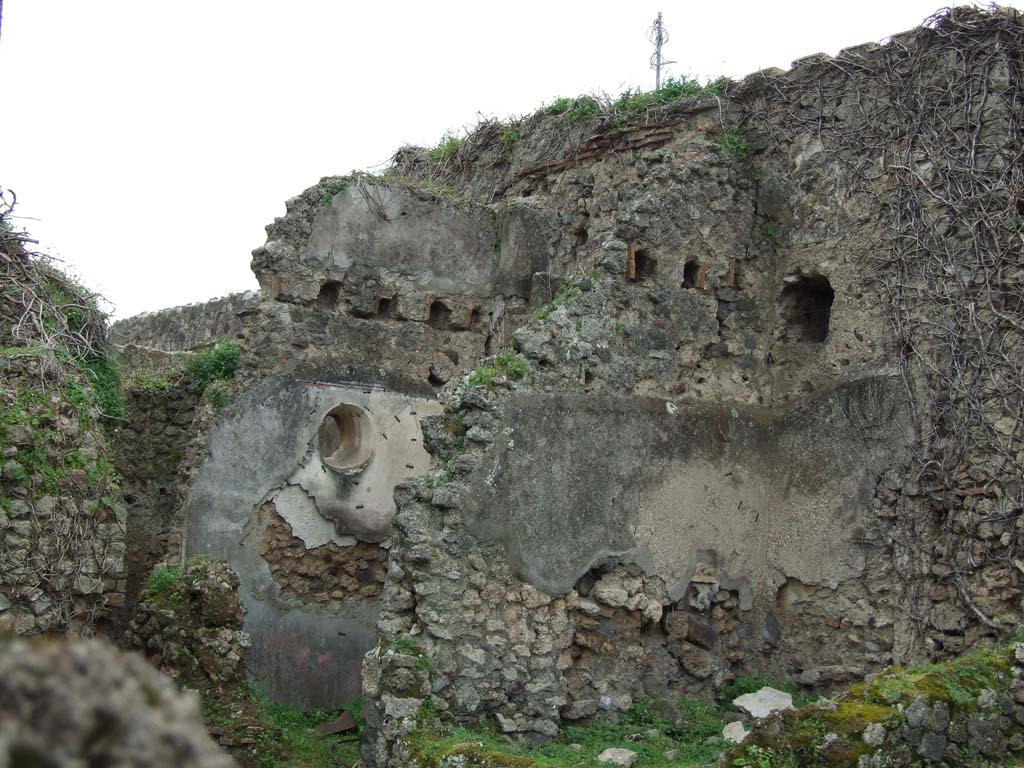
VII.3.11 Pompeii.
March 2009. Doorway to garden/peristyle with more surrounding rooms.
According to Boyce,
against the back wall of the garden stood an aedicula lararium.
He also said that
from the objects found in the dwelling, Fiorelli concluded that it was owned by
an Egyptian.
See Boyce G. K.,
1937. Corpus of the Lararia of Pompeii.
Rome:
MAAR 14. (p.64, no: 264B)
See Pappalardo, U., 2001. La
Descrizione di Pompei per Giuseppe Fiorelli (1875). Napoli: Massa Editore.
(p. 86)
According to Giacobello, the aedicula in the garden is no longer conserved.
See Giacobello, F., 2008. Larari
Pompeiani: Iconografia e culto dei Lari in ambito domestico. Milano: LED Edizioni. (p. 280, no. V65).
According to
Jashemski, against the rear wall was an aedicula shrine.
The shrine contained
statuettes of Lar, Minerva and Harpocrates, as well as a small terracotta
altar.
A lamp hung above.
On the ground in front of the aedicula was a masonry altar.
The walls on each
side of the shrine were painted with trees seen growing behind a wooden fence.
See Jashemski, W.
F., 1993. The Gardens of Pompeii, Volume
II: Appendices. New York: Caratzas. (p. 177).
Kitchen with lararium painting (now destroyed) at side of niche. (No photo of kitchen).

VII.3.11 Pompeii. 1867 drawing by Schulz of lararium painting in the kitchen, now destroyed.
DAIR 83.133.
Photo © Deutsches Archäologisches Institut, Abteilung Rom, Arkiv.
According to Boyce, In the wall of the kitchen was set a niche and between it and the hearth was the lararium painting (w. 2.32) in two zones.
In the centre of the upper zone (top damaged, h. uncertain) stands a blazing altar and to the r. of it the Genius, wearing a toga praetexta and holding in the left a cornucopia, in the right a patera above the altar.
Behind him comes a camillus in white tunic, carrying in right hand garlands and taeniae, in the left, with which he leads by a string a hog adorned with vittae, a large shallow dish containing several spits.
On the opposite side of the altar stands the tibicen in white tunic and red toga (sic) with his right foot upon a scabellum; behind him a very small, nude popa carries in his right the sacrificial knife, in his left a malleus.
On each side of this group is a Lar with rhyton and situla, leaning with one arm upon a pillar.
In the lower zone (h. 0.90) are two serpents confronted at an altar furnished with eggs and fruit.
See Boyce G. K., 1937. Corpus
of the Lararia of Pompeii. Rome:
MAAR 14, p.64, no. 265, pl. 19,1.
See Fröhlich, T.,
1991. Lararien und Fassadenbilder in den
Vesuvstädten. Mainz: von
Zabern, (p. 285, L82, Abb. 4.)
See Giacobello,
F., 2008. Larari Pompeiani: Iconografia e
culto dei Lari in ambito domestico. Milano: LED Edizioni. (p.191-2, no.75).
VII.3.13 Pompeii.
Deep square niche in north wall of garden area (described as a pseudo-aedicula).

VII.3.13 Pompeii.
December 2004. Double lararium on east side of garden area.

VII.3.13
Pompeii. Lararium on north wall of garden.
DAIR 31.2457. Photo ©
Deutsches Archäologisches Institut, Abteilung Rom, Arkiv.
According to Boyce,
in the N. wall of the viridarium, to the left of the entrance door, a deep,
square niche (0.84 square, d. 0,82, h. above the floor 1.15) is set in the
wall.
Its floor projects
slightly in the form of a ledge and beneath it runs a delicate cornice of
modelled and painted stucco.
On the wall below
the niche a rectangular panel is marked off by a moulding which runs around all
four sides.
The side walls of
the niche are adorned at their outer edges, each with a stucco pilaster fitted
with curious capitals, one higher than the other.
In the centre of the
back wall is a small aedicula facade formed by two columns (h. 0.25) which rest
upon a heavy projecting ledge adorned with a cornice of stucco and support a
pediment.
The back wall within
the aedicula is painted in imitation of marble.
In this miniature
shrine must have stood a statuette.
On the right-side
wall of the niche is a large wreath (diam. 0.70) of laurel and within it coils
a serpent, all done in stucco relief.
Around the top of
the three inside walls of the niche runs another stucco cornice.
In the floor is a
rectangular depression for offerings.
This shrine was
called the "Double Lararium", because above the niche we have
described there is another, similar to it in shape and size.
But in this upper
niche no traces of a cult were found and, in the absence of any real parallels
to such a double shrine, it is simpler to regard the upper niche as a place of
storage, comparable, perhaps, to the niches in the bases of the aediculae of the
houses of Obellius Firmus and the Principe di Napoli (Nos. 67, 214).
See Boyce G. K.,
1937. Corpus of the Lararia of Pompeii.
Rome:
MAAR 14, (p. 64, no. 266, pl. 32,1.)
Giacobello describes this as a pseudo-aedicula lararium.
See Giacobello, F., 2008. Larari
Pompeiani: Iconografia e culto dei Lari in ambito domestico. Milano: LED Edizioni. (p.192, p. 280, no.V66)
Niche in west wall of shop-room.

VII.3.13 Pompeii.
December 2018. Looking towards west wall with niche. Photo courtesy of Aude
Durand.

VII.3.13 Pompeii.
December 2018. Niche set into west wall. Photo courtesy of Aude Durand.
Lararium painting in kitchen. (No
photo).

VII.3.13 Pompeii. March 2009. South-west corner of garden area. Passage to kitchen, and two cubicula.
In the kitchen, there was a lararium painting, not conserved, height 0.59m, width 2.07m.
The genius poured a libation on an altar and on each side stood a Lar with rhyton and situla.
In the lower zone were the two serpents confronted at an altar.
See Boyce G. K., 1937. Corpus
of the Lararia of Pompeii. Rome:
MAAR 14, (p. 64, no. 267).
VII.3.21 Pompeii.
Small rectangular niche in kitchen. (No photo).

VII.3.21 Pompeii.
March 2009. Looking west towards garden area of VII.3.21.
This is at the rear
of the triclinium of VII.3.13, in the foreground.
Apart from the
garden area, there was also a small room or cupboard, kitchen and latrine.
According to Boyce –
in the east wall of
the kitchen between the hearth and the latrine, was a small rectangular niche
(h.0.28, w.0.25, d.0.17, h. above floor 1.20).
Inside the niche,
its walls were coated with red stucco.
See Boyce G. K.,
1937. Corpus of the Lararia of Pompeii.
Rome:
MAAR 14. (p. 64, no. 268).
VII.3.22/23 Pompeii.
Painting of serpents. (No photo).
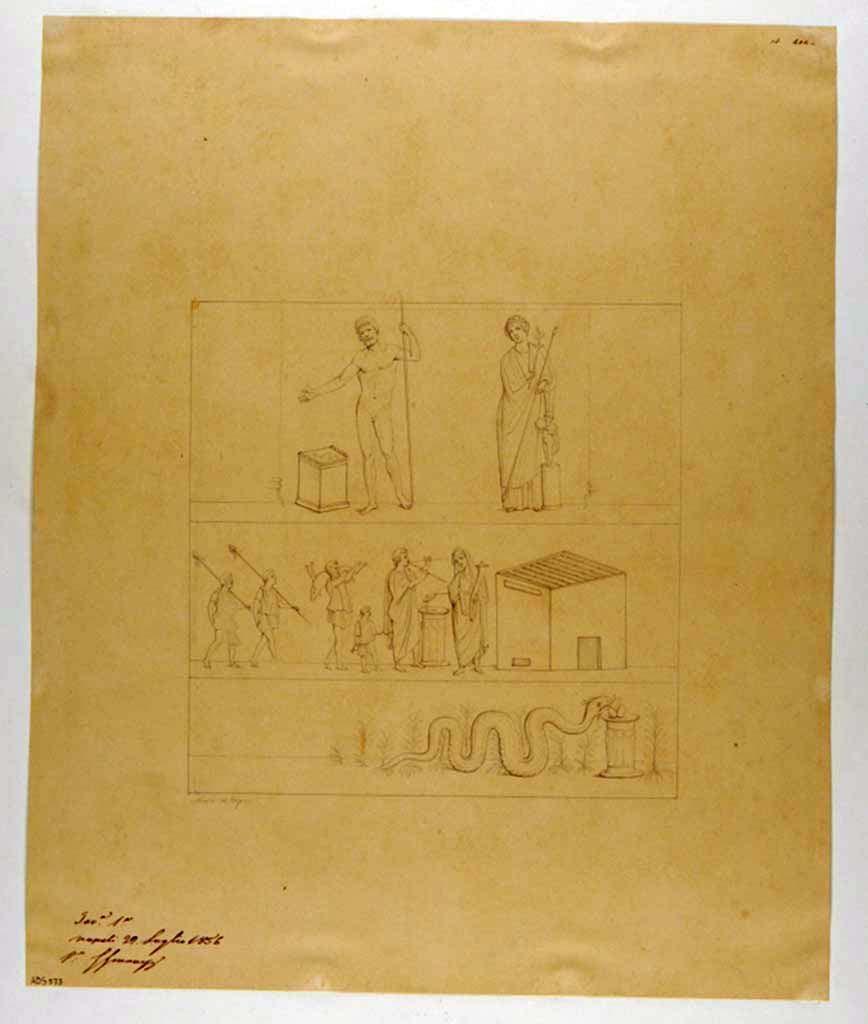
VII.3.23 Pompeii. May 2010.
Looking west from the small atrium towards the garden, on the left, and rear corridor to kitchen, on the right.
According to Liselotte Eschebach the small atrium had a sacellum and garden.
See Eschebach, L., 1993. Gebäudeverzeichnis und Stadtplan der antiken Stadt Pompeji. Köln: Böhlau. (p.269)
According to Boyce, on the wall of one of the rear rooms of VII.3.22/23, was a painting of two serpents confronted at an altar.
In the background were plants and among them, at the time, was visible the tail of a third serpent, but the rest of the body had disappeared.
Below the painting was the graffito: LARES
PROPI
tiOS [CIL IV 844]
He quoted Bull.
Arch. Nap., ii, 1844, 4.
See Boyce G. K., 1937. Corpus
of the Lararia of Pompeii. Rome:
MAAR 14. (p.65, no.269).
VII.3.29 Pompeii.
Semi-circular niche, with painted pediment above, and painted serpent and altar below.

VII.3.29 Pompeii. March 2009. Room 12,
corridor. Looking east.
On the east side of the corridor was the
garden area.
According to Boyce, in the south-west corner
of the portico of the garden was a semi-circular niche.
See Boyce G. K., 1937. Corpus of the Lararia of Pompeii. Rome: MAAR 14. (p.65, no. 270, Pl. 4,1)
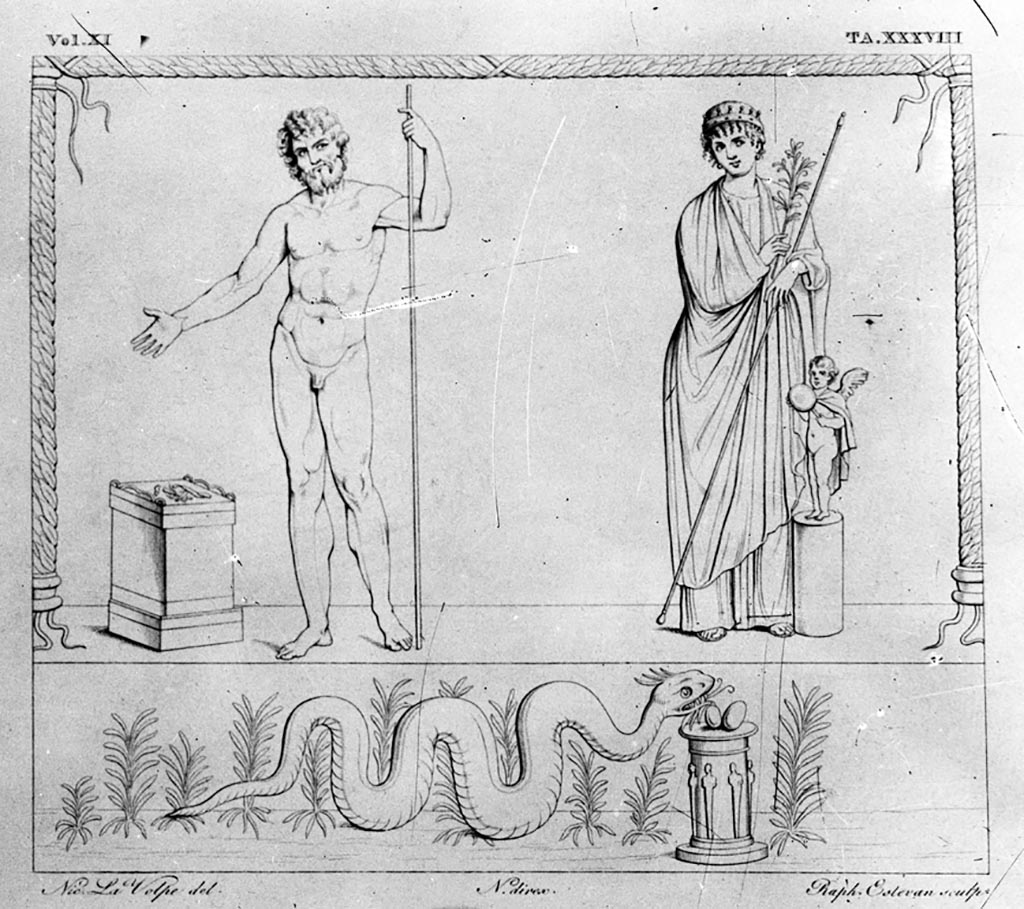
VII.3.29 Pompeii.
According to Boyce –
in the south-west
corner of the portico of the garden was a semi-circular niche (h.0.67, w.0.62,
d.0.46, h. above floor 1.25).
Its vaulted ceiling
was adorned with a painted shell.
Painted on the wall
above the niche was a pediment and below it a single serpent beside an altar.
See Boyce G. K.,
1937. Corpus of the Lararia of Pompeii.
Rome:
MAAR 14. (p.65, no. 270, Pl. 4,1)
VII.4.20 Pompeii.
Lararium painting on north wall of courtyard/kitchen.
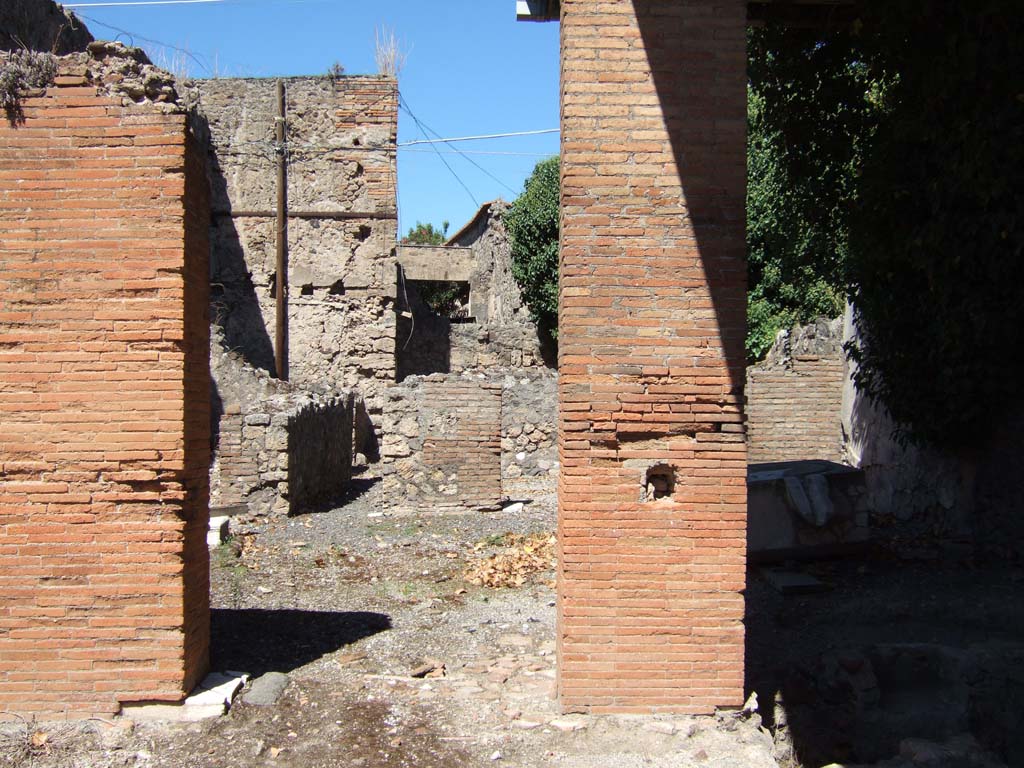
VII.4.20 Pompeii.
March 2009. North and east wall of shop room.
(Note that the north
wall is modern and has effectively reduced the size of the original large
shop-room by about half).
According to
Fiorelli, at the rear of this shop-room was a triclinium, preceded by the
stairs to the upper rooms, and skirted by a corridor that came into a small
courtyard/garden, and where to the left were two small rooms and the main
garden area. To the right and covered by a lean-to roof was the kitchen,
latrine, cistern and perhaps also a store-room. Painted on the rear north wall
of the courtyard, facing the corridor, was the lararium, but nothing remains of
it today, other than the drawing by La Volpe and the incision of Museo
Borbonico.
See Pappalardo, U., 2001. La
Descrizione di Pompei per Giuseppe Fiorelli (1875). Napoli: Massa Editore. (p.90).

VII.4.20 Pompeii. Drawing by Nicola La Volpe of
lararium painting from north wall of kitchen.
Nothing remains of the painting.
Now in Naples
Archaeological Museum. Inventory number ADS 573.
Photo © ICCD. https://www.catalogo.beniculturali.it/
Utilizzabili alle condizioni della licenza Attribuzione -
Non commerciale - Condividi allo stesso modo 2.5 Italia (CC BY-NC-SA 2.5 IT)
On the north wall of
the kitchen is a lararium painting in three zones.
In the upper zone
were Jupiter and Venus Pompeiana.
In the middle zone
was the sacrificial scene.
In the lowest zone a
single serpent approaches an altar from the left.
See Boyce G. K.,
1937. Corpus of the Lararia of Pompeii.
Rome: MAAR 14. (271, p.65, Pl 18,2).
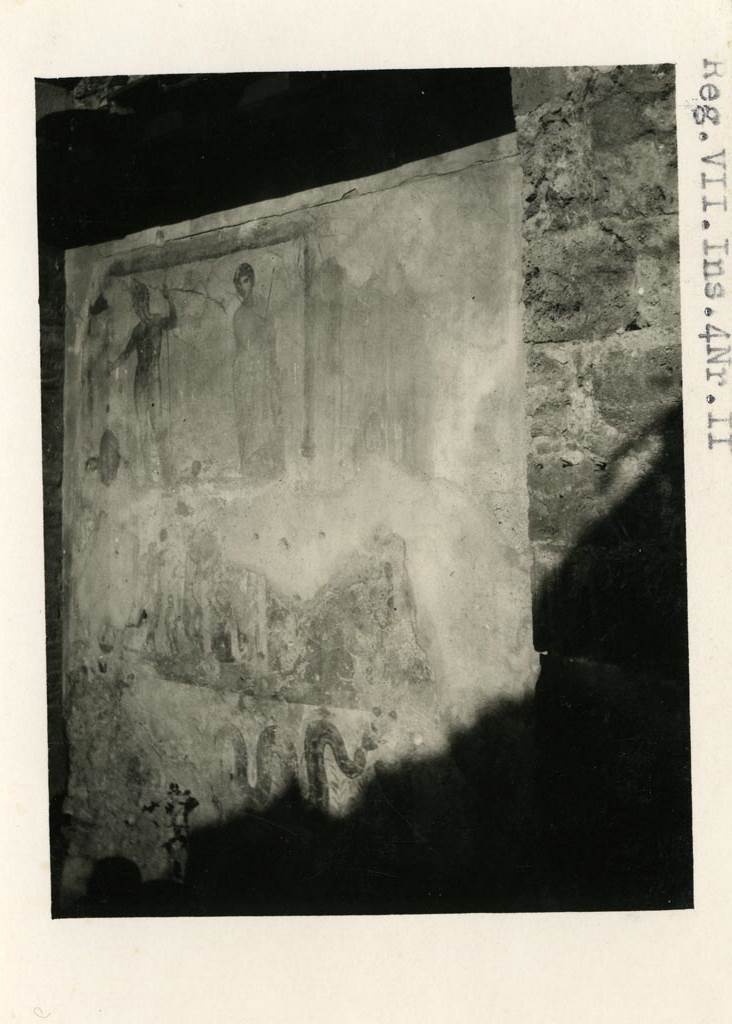
VII.4.20, Pompeii, but shown as VII.4.11 on photo. Pre-1937-39.
Lararium from north wall of courtyard.
Photo courtesy of American Academy in Rome,
Photographic Archive. Warsher collection no. 1905.
According to Fröhlich
In the courtyard with
the Lararium painting, the kitchen, the latrine and a cistern are located on
the east side under one roof.
See Fröhlich, T., 1991. Lararien und Fassadenbilder in den
Vesuvstädten. Mainz: von Zabern, (L83, p. 285-6, abb. 5 and
6.)
![VII.4.20 Pompeii. W.15. About 1835. North wall of kitchen of dwelling house. Sketch by N. La Volpe of Lararium painting.
In the upper zone were Jupiter and Venus Pompeiana.
In the middle zone was the sacrificial scene.
In the lowest zone a single serpent approached an altar from the left.
See Boyce G. K., 1937. Corpus of the Lararia of Pompeii. Rome: MAAR 14. (271, p.65, Pl 18,2).
See Real Museo Borbonico XI, Plate 38.
Photo by Tatiana Warscher. Photo © Deutsches Archäologisches Institut, Abteilung Rom, Arkiv.
According to Fröhlich
In the uppermost zone of the picture stands Venus Pompeiana on the right with the mural crown [a crown representing city walls or towers] and in a violet chiton and blue cloak.
She puts weight on her right leg, leans on the rudder with her left arm and holds a branch in front of her chest with her right hand.
To her left is a small Eros in brown chlamys and holding a mirror on a round base. Jupiter is standing naked on his right leg on the left.
He holds the scepter in his raised left hand and makes an offering with his right hand over a square altar at his side.
The picture is framed by two columns entwined with foliage, standing on candelabrum feet and joined together at the top by a similarly entwined beam.
In the lower zone, the bottom part of this picture, a snake moves between sparse plants to the right towards a round altar.
See Fröhlich, T., 1991. Lararien und Fassadenbilder in den Vesuvstädten. Mainz: von Zabern, L83, p. 285-6, abb. 5 and 6.](Pompeii%20Household%20Shrines%20p9_files/image138.jpg)
VII.4.20 Pompeii.
W.15. About 1835. North wall of kitchen of dwelling house. Sketch by N. La
Volpe of Lararium painting.
According to Boyce –
On the north wall of the kitchen is a lararium painting in three zones.
In the upper zone
were Jupiter and Venus Pompeiana.
In the middle zone
was the sacrificial scene.
In the lowest zone a
single serpent approached an altar from the left.
See Boyce G. K.,
1937. Corpus of the Lararia of Pompeii.
Rome: MAAR 14. (271, p.65, Pl 18,2).
See Real Museo Borbonico XI, Plate 38.
Photo by Tatiana Warscher. Photo © Deutsches Archäologisches Institut,
Abteilung Rom, Arkiv.
According to
Fröhlich
In the uppermost zone of the picture stands Venus Pompeiana on the right
with the mural crown [a crown representing city walls or towers] and in a violet chiton and blue cloak.
She puts weight on her right leg, leans on the rudder with her left arm and
holds a branch in front of her chest with her right hand.
To her left is a small Eros in brown chlamys and holding a mirror on a
round base. Jupiter is standing naked on his right leg on the left.
He holds the scepter in his raised left hand and makes an offering with his
right hand over a square altar at his side.
The picture is framed by two columns entwined with foliage, standing on
candelabrum feet and joined together at the top by a similarly entwined beam.
In the lower zone, the bottom part of this picture, a snake moves between
sparse plants to the right towards a round altar.
See Fröhlich, T., 1991. Lararien und
Fassadenbilder in den Vesuvstädten. Mainz: von Zabern, L83, p. 285-6, abb. 5 and 6.
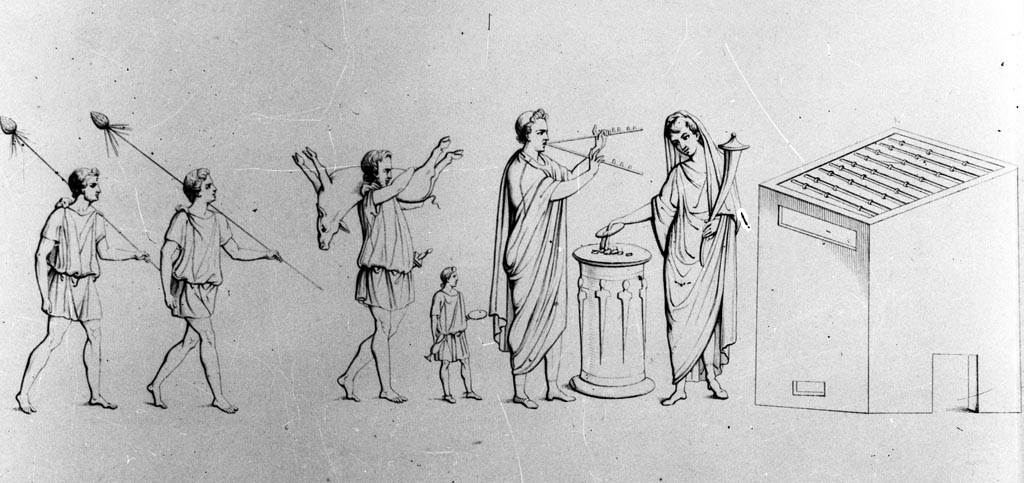
VII.4.20 Pompeii.
W.16. About 1835. North wall of kitchen of dwelling house. Sketch of Lararium painting middle zone with
a sacrificial scene.
Photo by Tatiana Warscher. Photo © Deutsches Archäologisches Institut,
Abteilung Rom, Arkiv.
According to Fröhlich, on the far right
of the more minimized middle zone appears a rectangular shape, a house or a
large hearth.
To the left of this is the Genius sacrificing at the round altar, to whom a
procession of five people is approaching from the left: a large Tibicen in a
white toga, a small Camillus in a white tunic, a Popa with a beard in a
yellowish tunic, who is carrying a pig on his left shoulder, and finally two
men, shouldering thyrsus-like staffs, in short tunics.
See Fröhlich, T., 1991. Lararien und
Fassadenbilder in den Vesuvstädten. Mainz: von Zabern, L83, p. 285-6, abb. 5 and 6.
See Real Museo Borbonico XI, Plate 37.
See Giacobello, F., 2008. Larari Pompeiani: Iconografia e culto dei Lari
in ambito domestico. Milano: LED Edizioni, (p.193, no.77).
VII.4.24-25 Pompeii.
Painting, west wall of kitchen. (No photo).
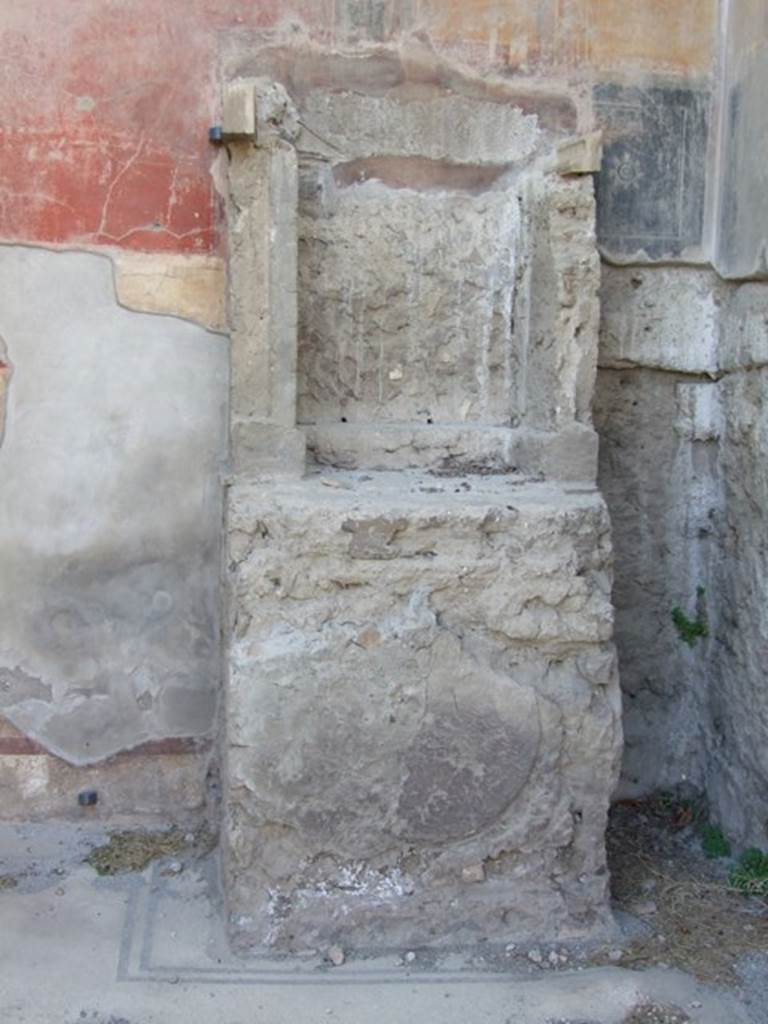
VII.4.25 Pompeii.
September 2005. Doorways from VII.4.24 and VII.4.25 to rear rooms.
According to Boyce,
on the west wall of the kitchen above the hearth, was a Lararium painting in
two zones on a white background.
It showed the Genius
pouring a libation upon an altar. On each side of him was a Lar in a blue tunic
and red pallium.
Instead of the
customary serpents, the lower zone was filled with a second sacrificial scene,
but only the popa remains.
He held a knife in
his right hand and held a hog with his left.
The hog was adorned
with a red band around its belly and a garland.
See Boyce G. K.,
1937. Corpus of the Lararia of Pompeii.
Rome: MAAR 14. (p.65, no.272)
According to Garcia
y Garcia, all the rear parts of this dwelling were damaged by the bombing in September
1943.
Demolition of the
atrium, fauces and two other rooms in this area occurred, including the falling
of the painted fourth style plaster.
See Garcia y Garcia, L., 2006. Danni di guerra
a Pompei. Rome: L’Erma di Bretschneider. (p. 97)
According to
Fröhlich, only slight faded traces of the lararium painting remain.
See Fröhlich, T., 1991. Lararien und
Fassadenbilder in den Vesuvstädten. Mainz: von Zabern. (p.286, L84).
See Giacobello, F., 2008. Larari Pompeiani:
Iconografia e culto dei Lari in ambito domestico. Milano:
LED Edizioni, (p.193, no.78)
VII.4.26 Pompeii.
Painting on south wall of kitchen, no traces remain.
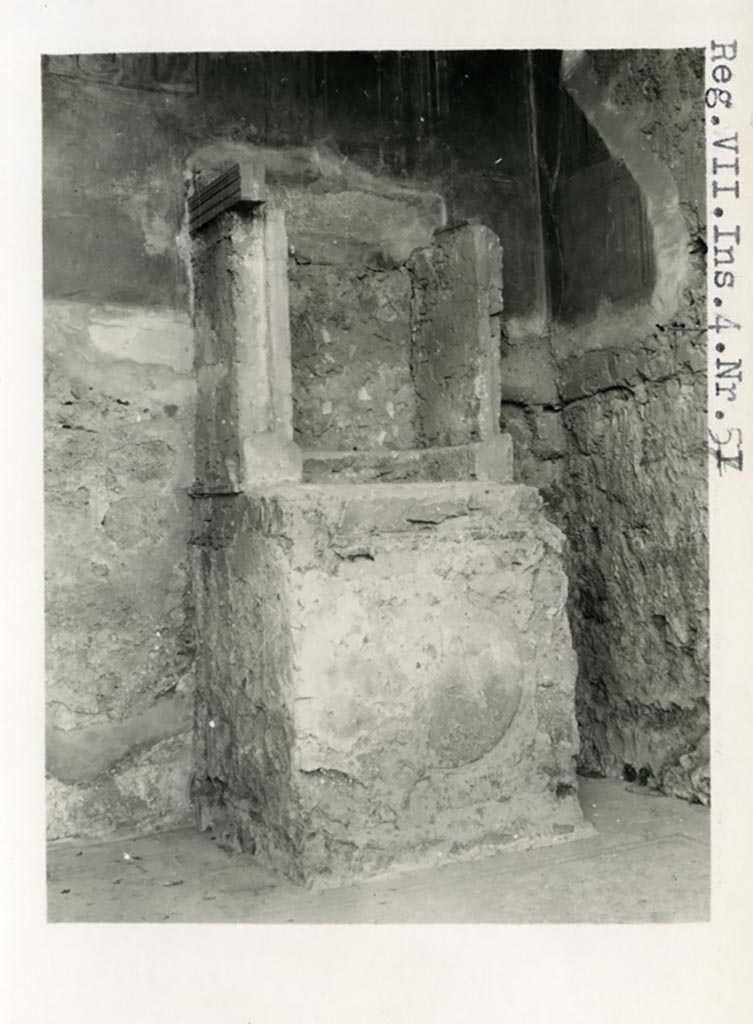
VII.4.26 Pompeii. December 2007. Shop entrance to workshop/dwelling.
According to Fiorelli, the atrium with an impluvium would have been at the rear of the shop-room, on whose right side would have been positioned the ala, the storeroom containing the stairs to the upper rooms, and the cubiculum decorated with gladiatorial scenes.
At the rear, there was a small room bordered by the corridor, as well as a triclinium with entrance from the same corridor, which in its length gave access to three other rooms, a small garden and the kitchen, which had a separate latrine, and in the wall against the hearth showed a painting with Hercules before the altar, assisted by the Tibicine between the two Lares: in the lower part of the painting were two men with an amphora, and other amphorae on a cart. On the side wall, were the painted serpents and table.
See Pappalardo, U., 2001. La Descrizione di Pompei per Giuseppe Fiorelli (1875). Napoli: Massa Editore. (p.90).
According to Eschebach, the kitchen would have been at the rear of the dwelling.
See Eschebach, L., 1993. Gebäudeverzeichnis und Stadtplan der antiken Stadt Pompeji. Köln: Böhlau. (p.278)
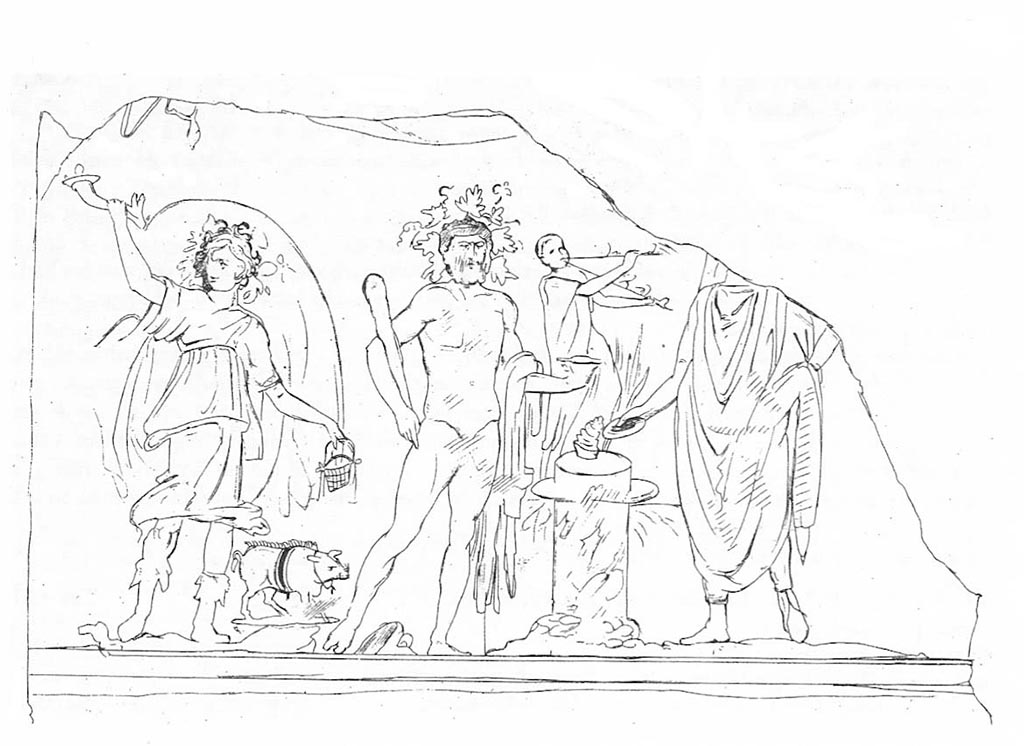
According to Boyce and Frohlich, the lararium was on the south wall of the kitchen on a white background.
Frohlich wrote that the painting has now faded and vanished.
On the right of a blazing altar stood the Genius, behind the altar the tibicen was visible.
On the opposite side of the altar stood Hercules and behind him was a hog with a bell around its neck.
On the left of this group stood a Lar of smaller stature than the others. The Lar on the right had vanished.
Below these figures were painted numerous objects, now faded, including flasks and amphorae.
To the right of these objects, two young men wrestle for the possession of an amphora, each holding onto one of the handles.
With their other hand they each hold onto each other’s hair.
The two serpents were painted on an adjoining wall.
See Boyce G. K., 1937. Corpus of the Lararia of Pompeii. Rome: MAAR 14. (p.65, no.273).
See Fröhlich, T., 1991. Lararien und Fassadenbilder in den
Vesuvstädten. Mainz: von
Zabern. (p.286, L85, Abb.7).
See Helbig, W., 1868. Wandgemälde der vom Vesuv verschütteten Städte Campaniens. Leipzig: Breitkopf und Härtel, 69, taf. III.
VII.4.31/51 Pompeii.
Aedicula lararium in west ala, in north-west corner of atrium.
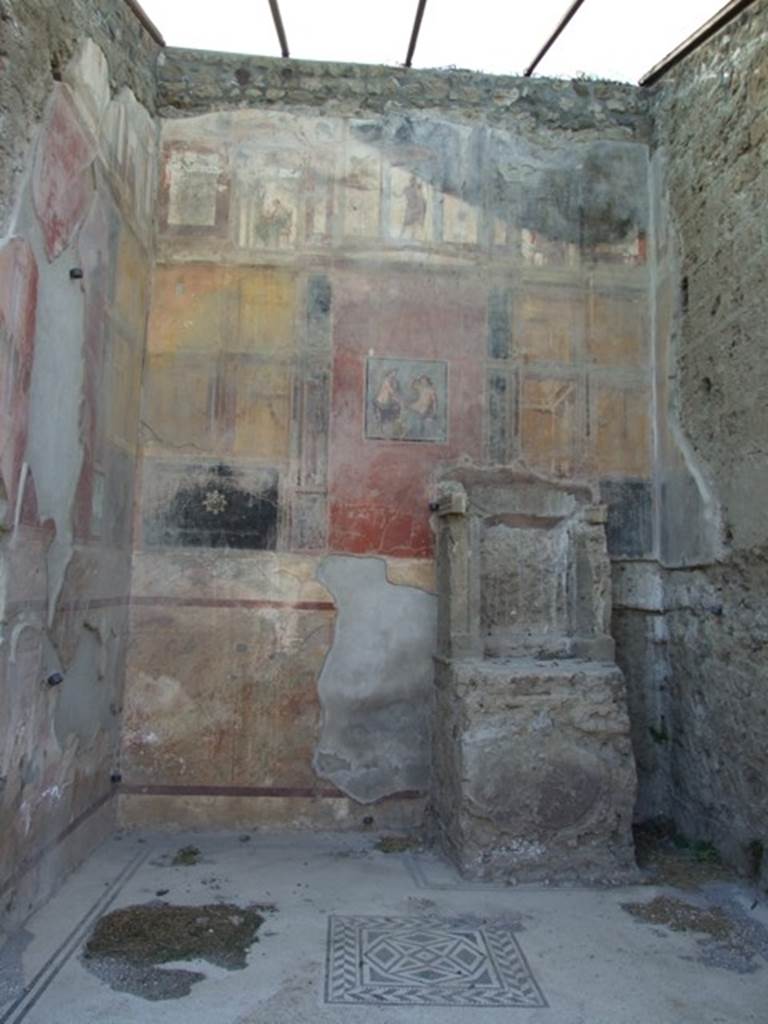
VII.4.31/51 Pompeii.
March 2009. Room 6, west wall of ala.
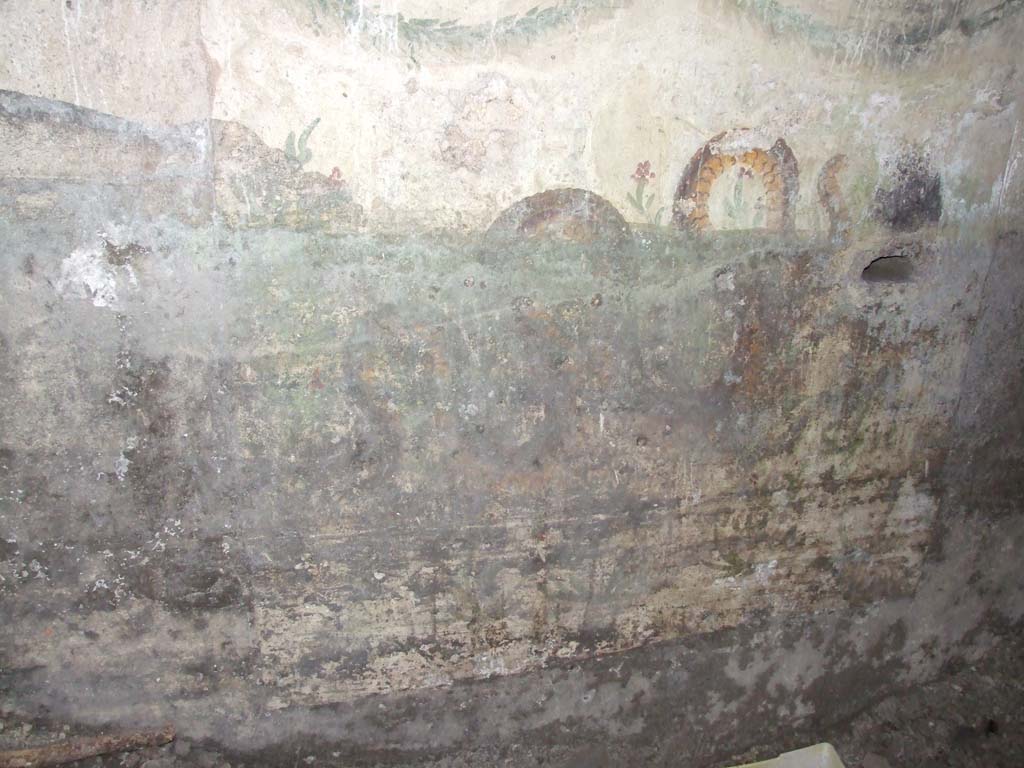
VII.4.31/51 Pompeii.
March 2009. Room 6, lararium against west wall.
On the front of the
base there is an impression of a round plaque in the plaster.
This must have once
decorated it.
According to Boyce –
in the left ala of the atrium stands an aedicula lararium.
Above a high podium
(1.10 by 0.93, h.1.22), walls enclose a rectangular niche (h.0.96, w.0.80,
d.0.50), the sides of which are reported to have been originally covered with
marble.
See Boyce G. K.,
1937. Corpus of the Lararia of Pompeii.
Rome:
MAAR 14. (p.66, no. 277)
See Giacobello, F., 2008. Larari Pompeiani: Iconografia e culto dei Lari
in ambito domestico. Milano:
LED Edizioni, (p.244, no.A26)
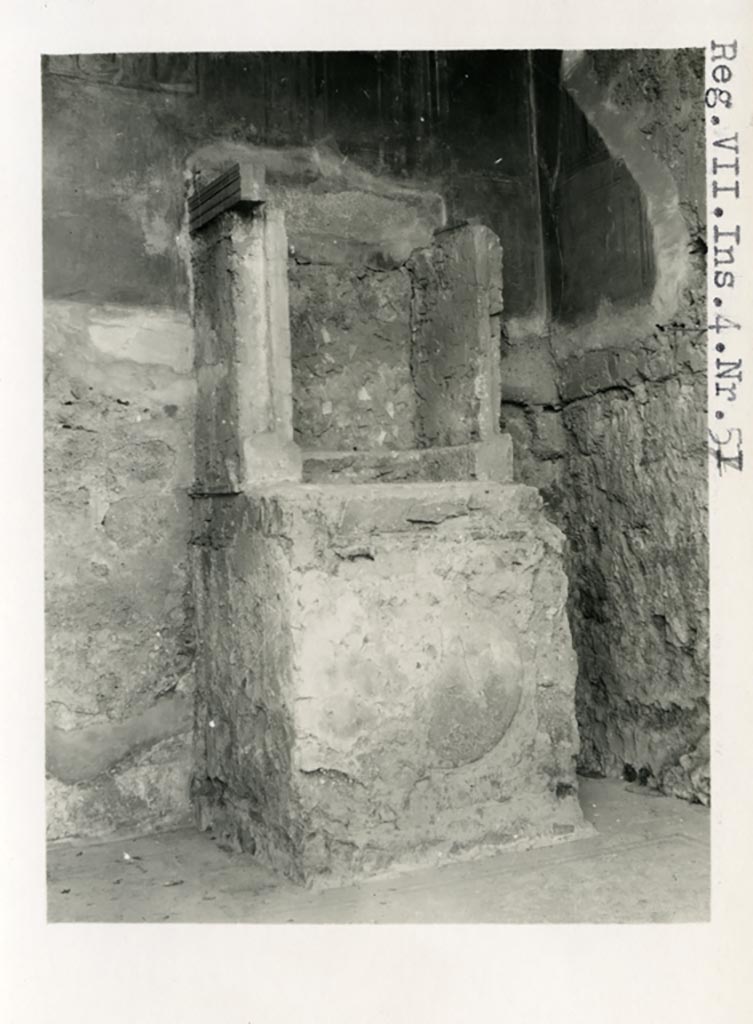
VII.4.31/51 Pompeii. pre-1937-39. Room 6, lararium against west wall.
Photo courtesy of American Academy in Rome,
Photographic Archive. Warsher collection no. 1904.
Lararium painting on east wall in kitchen.
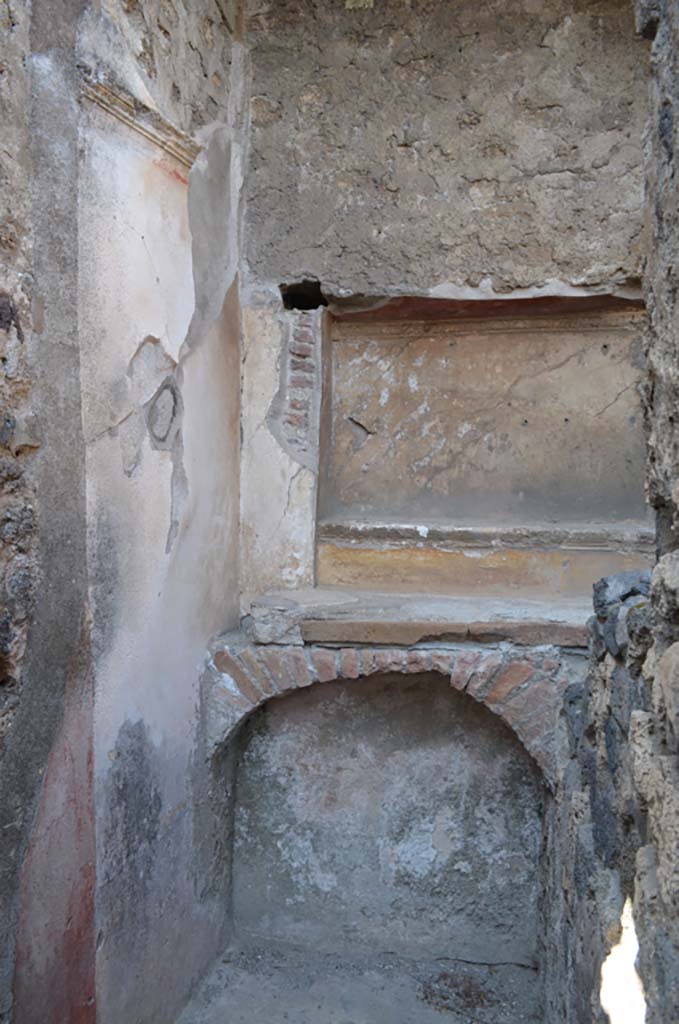
VII.4.31/51 Pompeii. March 2009. Room 27,
doorway to cellar.
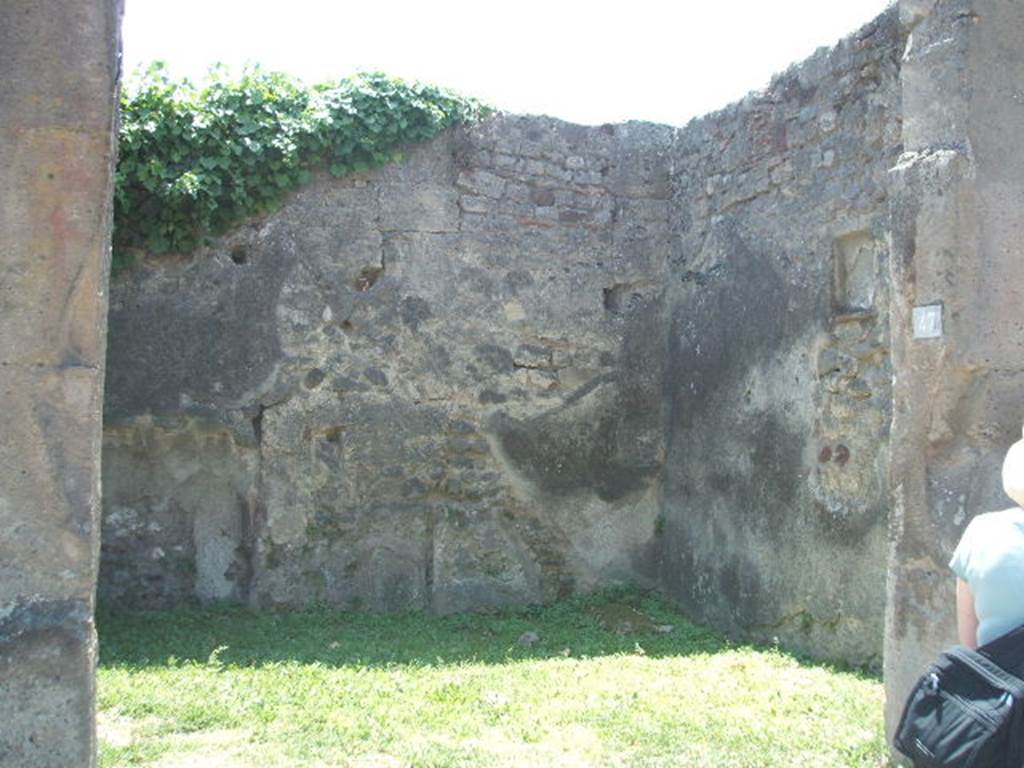
VII.4.31/51 Pompeii. March 2009. Room 27,
east wall of cellar. Lararium painting, small niche, garland and serpent.
According to Fröhlich this had a few defects,
moderately faded in places, very dirty in the lower part.
There was a white painted wall surface with
sacrificial plate.
A big snake moves slightly ascending to the
right.
In the oblong hole under the head of the
serpent destroyed today, a wooden sacrificial plate was certainly attached.
The picture background is filled with small
perennial plants and oleander-like shrubs, both with red flowers.
At the upper edge two garlands are painted,
over whose three attachment points in each case remnants of nails stuck in the
wall, which apparently served for the attachment of real garlands.
See Fröhlich, T., 1991. Lararien und Fassadenbilder in den
Vesuvstädten. Mainz: von Zabern, (L86, p. 287).
According to Boyce – Helbig saw the remains
of a fragmentary lararium painting with the figures of the Lares. (Helbig, 90).
See Boyce G. K., 1937. Corpus of the Lararia of Pompeii. Rome: MAAR 14, (p. 66, no. 278).
See Giacobello, F.,
2008. Larari Pompeiani: Iconografia e culto dei Lari in ambito domestico.
Milano: LED Edizioni, (p.194, no.79)
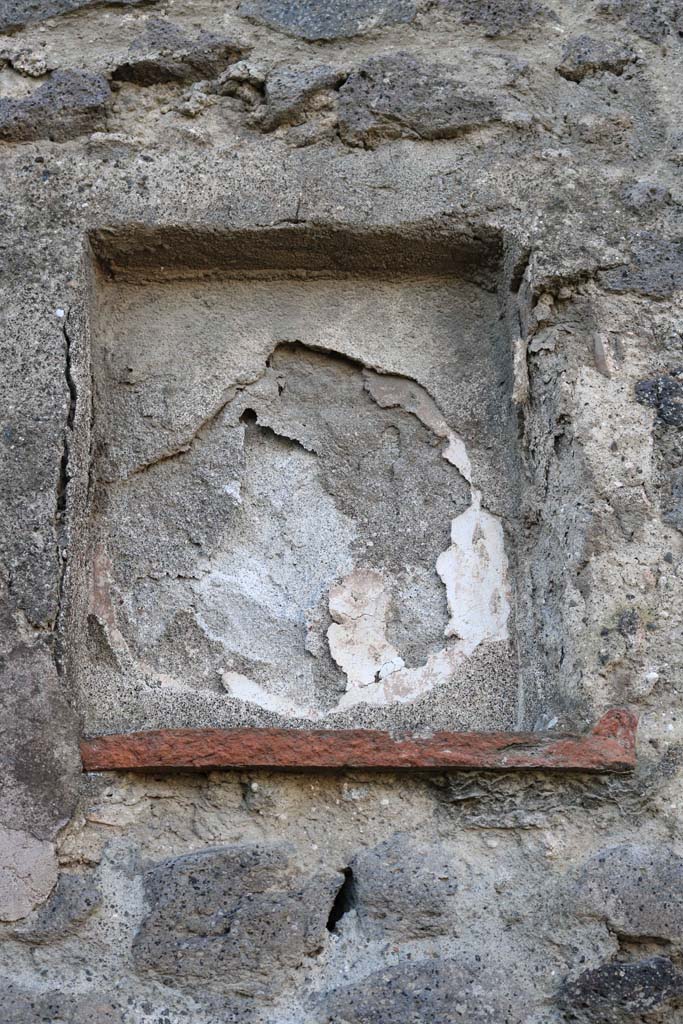
VII.4.31/51 Pompeii. March 2009. Room 27,
east wall of cellar. Lararium painting.
Aedicula/niche in room in south-west corner of second peristyle.
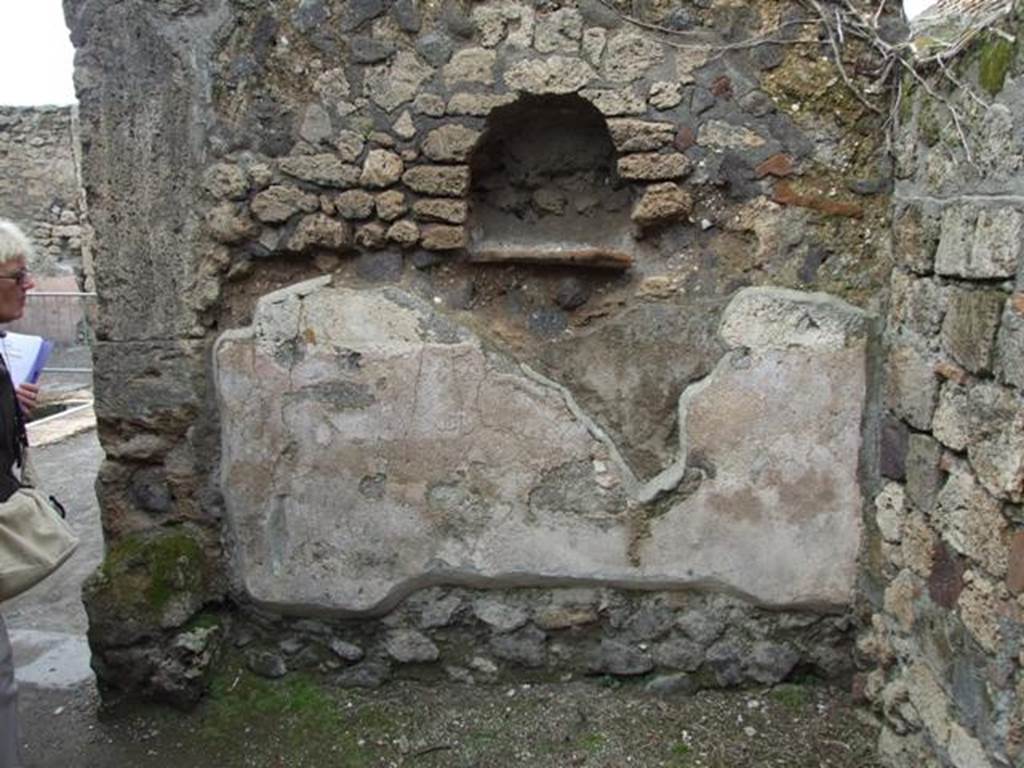
VII.4.31/51 Pompeii.
March 2009. Entrance to room 39, lararium.
According to Boyce,
in this room was a lararium, probably a niche, described merely as “un’edicola
per la imagine di qualque …. divinità”
See Boyce G. K.,
1937. Corpus of the Lararia of Pompeii.
Rome:
MAAR 14. (p.66)
See Giacobello, F., 2008. Larari Pompeiani: Iconografia e culto dei Lari
in ambito domestico. Milano:
LED Edizioni, (p.281 no.V67)
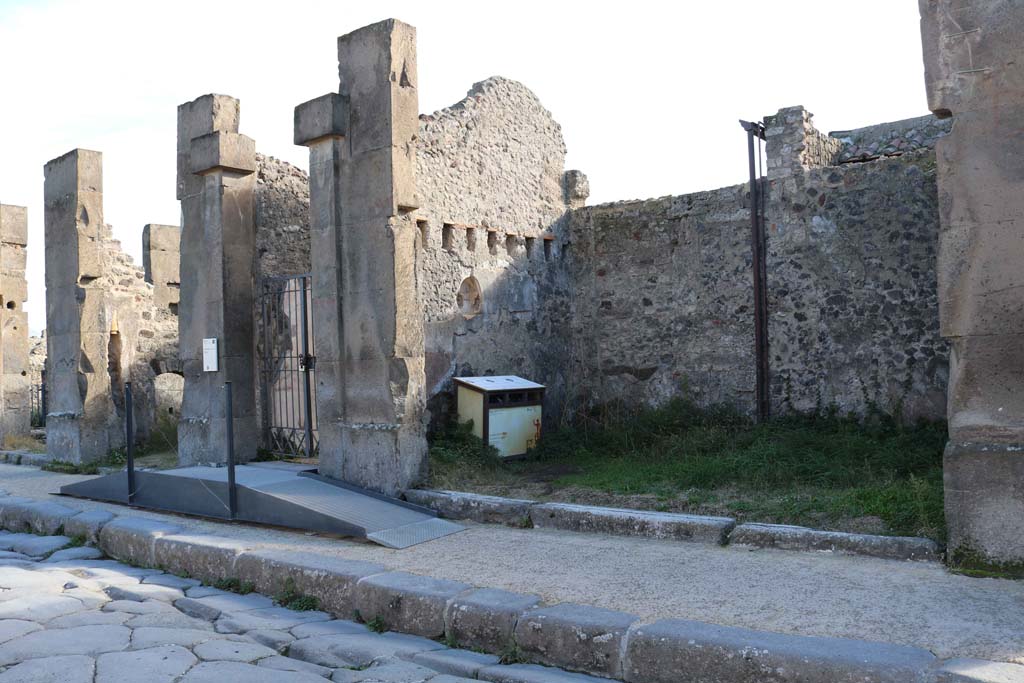
VII.4.31/51 Pompeii.
September 2019. Room 39, niches on west wall.
Foto Annette Haug, ERC Grant 681269 DÉCOR.
VII.4.47 Pompeii.
Rectangular niche in west wall of shop-room.
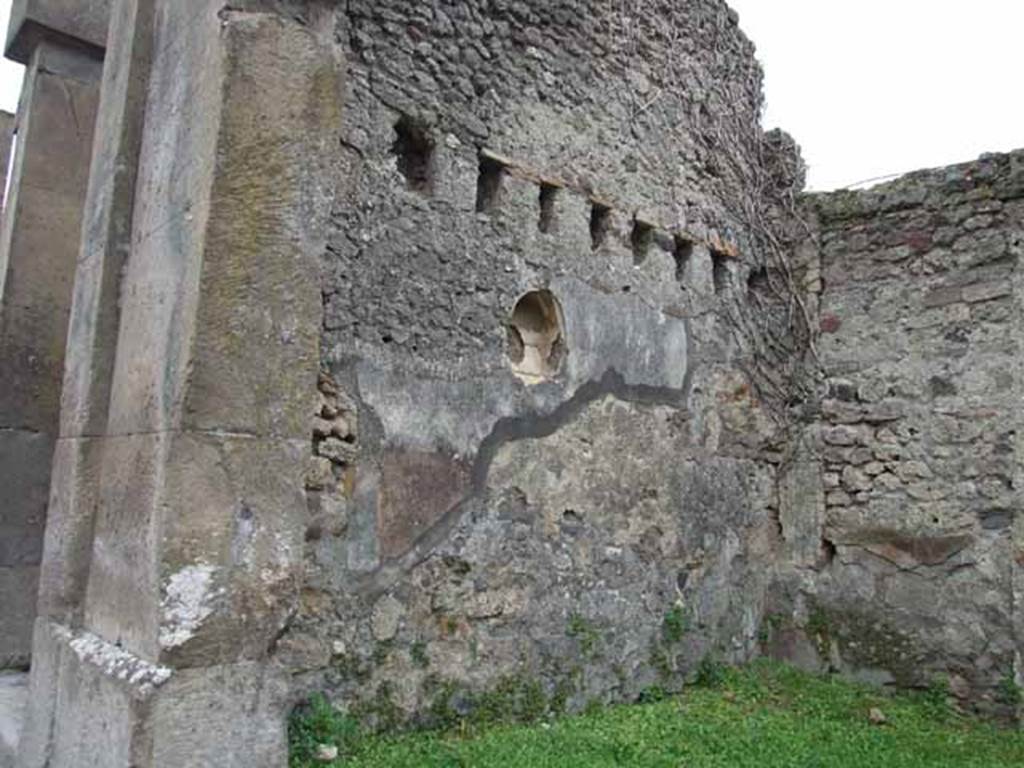
See Boyce G. K.,
1937. Corpus of the Lararia of Pompeii.
Rome: MAAR 14. (p.65, no.274)
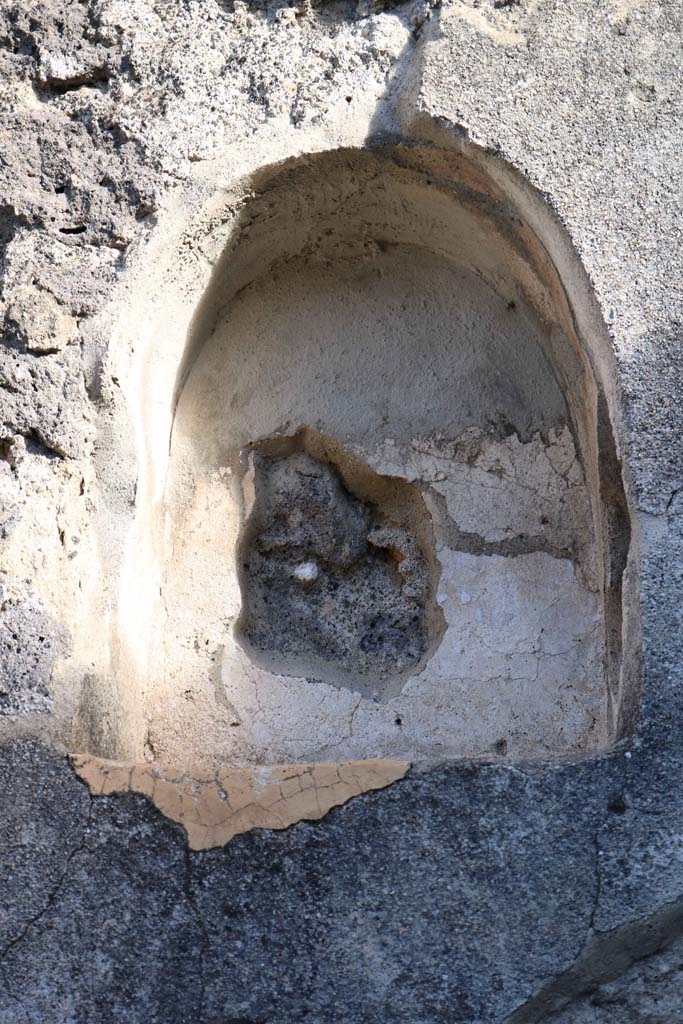
Rectangular niche (h. 0.45, w.0.38, d.0.13, h. above floor 2.0) set into west wall of shop-room.
Photo courtesy of Aude Durand.
VII.4.48 Pompeii.
Arched niche, north wall of room 9, (PPM room 8).
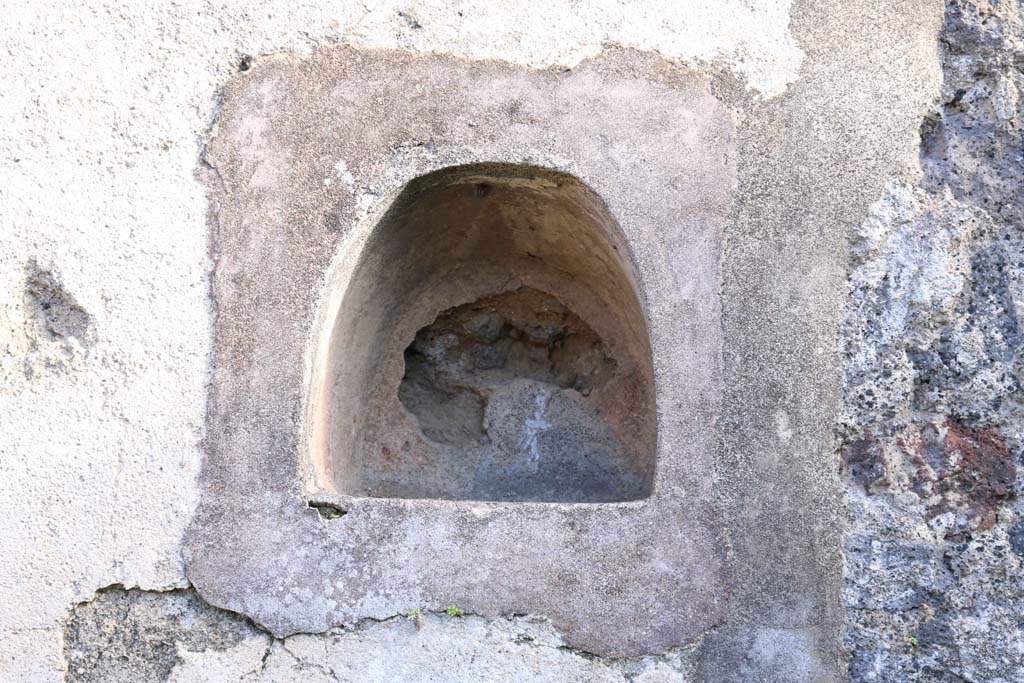
VII.4.48 Pompeii.
March 2009. Room 9, north wall with arched niche (h.0.40. w.0.48, d.0.25.h.
above floor 1.50) with tile shelf.
See Boyce G. K.,
1937. Corpus of the Lararia of Pompeii.
Rome:
MAAR 14. (p.66, no.275)
See Giacobello, F., 2008. Larari Pompeiani: Iconografia e culto dei Lari
in ambito domestico. Milano: LED Edizioni, (p.291, no.C16)
VII.4.49 Pompeii.
Niche in east wall of shop-room.
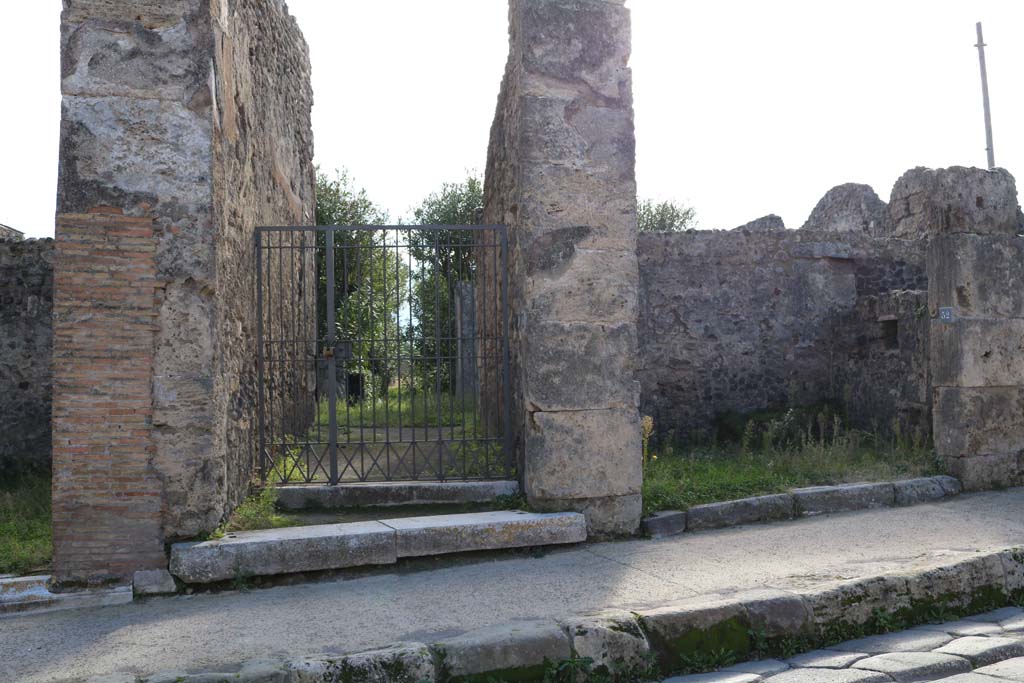
VII.4.49
Pompeii. December 2018.
Looking south from Via della Fortuna towards
entrance doorway. Photo courtesy of Aude Durand.
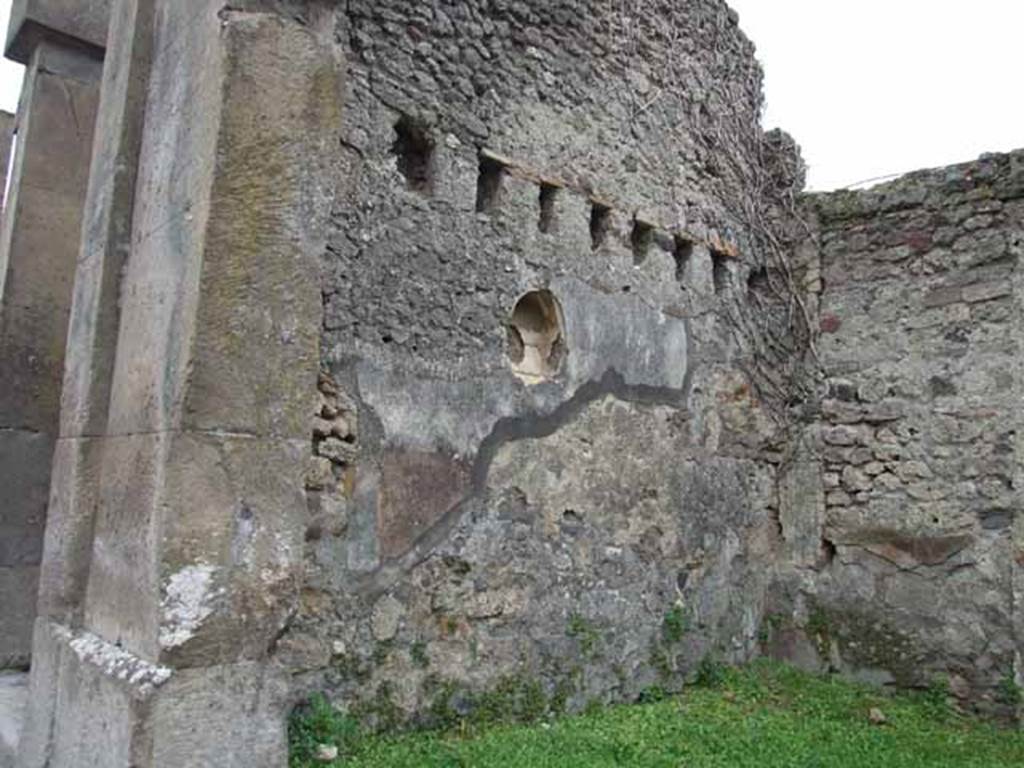
VII.4.49 Pompeii.
May 2010. East wall with niche. The staircase to the upper floor used to be against
this wall.
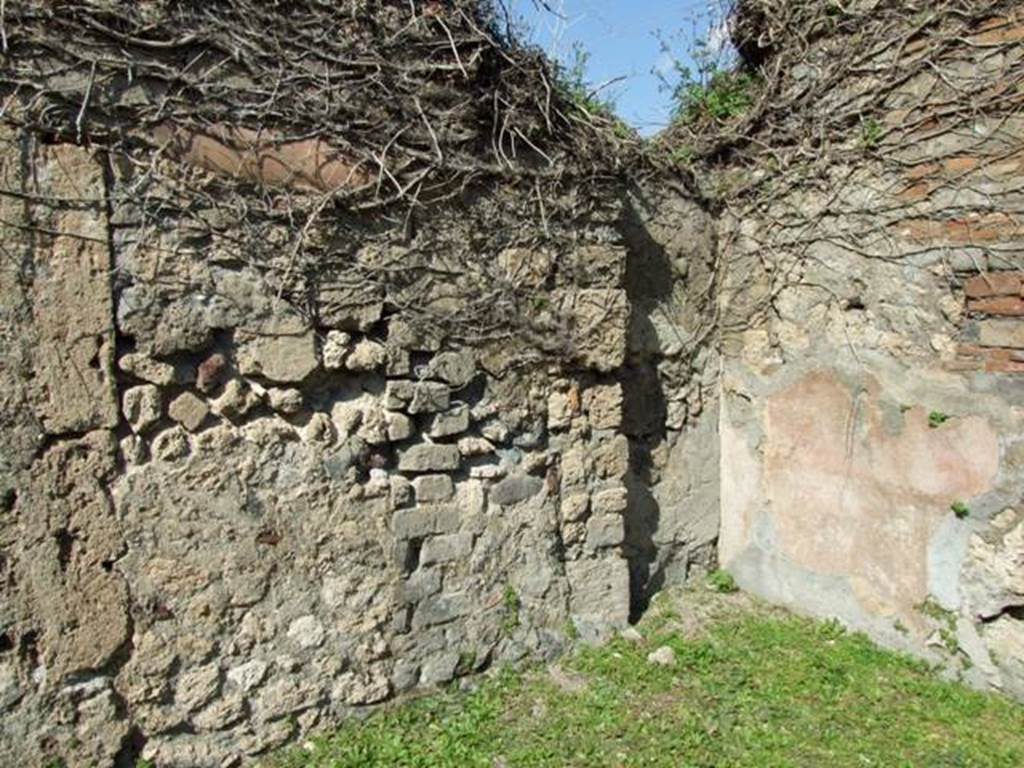
VII.4.49 Pompeii. December
2018.
East wall with niche
(h.0.48, w.0.40, d.0.20, h. above floor 1.90) set above the stairs.
Photo courtesy of Aude Durand.
According to Boyce,
its inside was coated with white stucco.
It was called by
Fiorelli la nicchia de’ Penati.
See Boyce G. K.,
1937. Corpus of the Lararia of Pompeii.
Rome:
MAAR 14. (p. 66, no. 276).
VII.4.52 Pompeii.
Niches in east and west wall of shop-room.
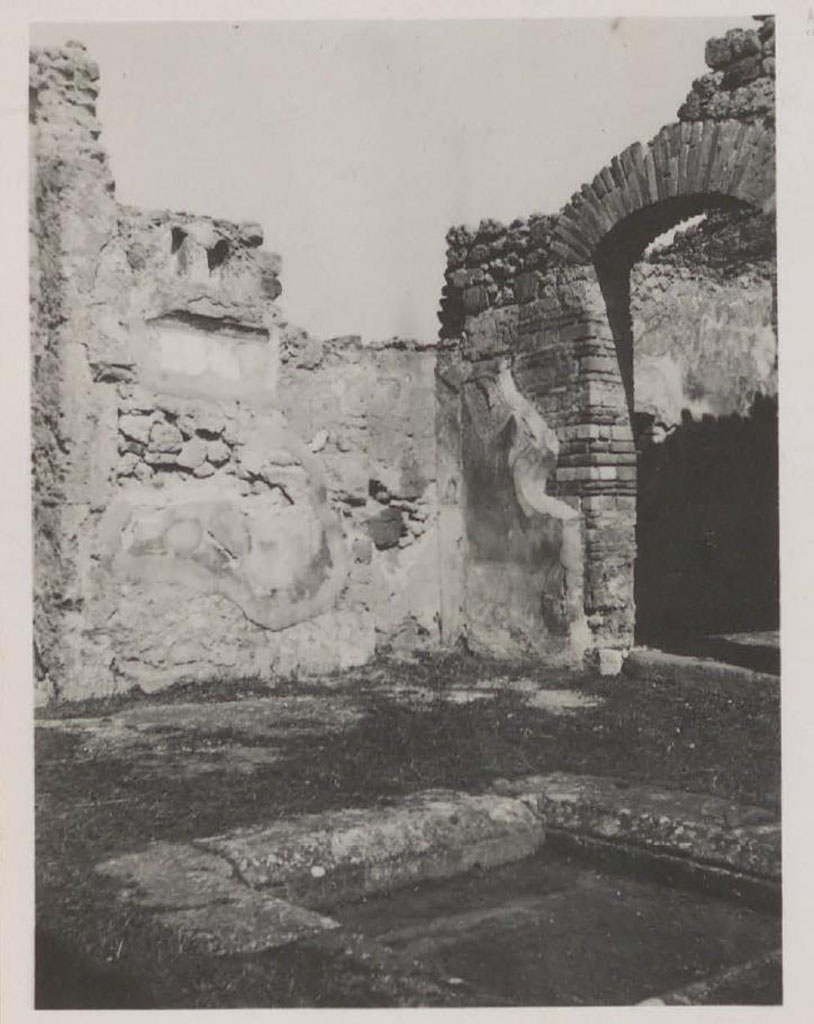
VII.4.52 Pompeii, on right. December 2018.
Looking south from Via della Fortuna towards entrance doorway. Photo courtesy of Aude Durand.
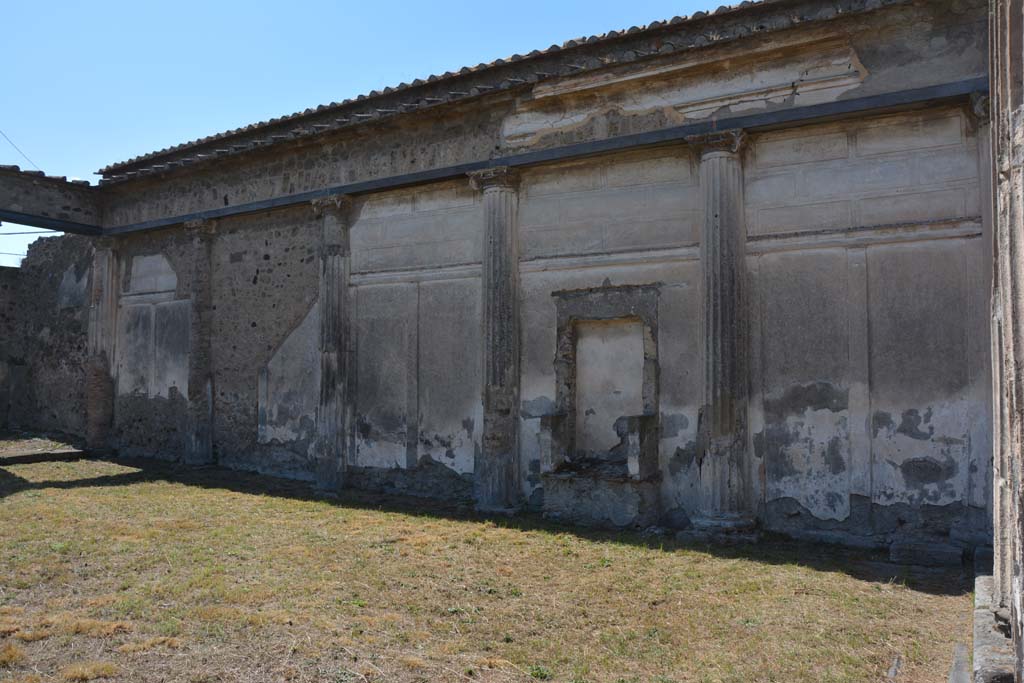
VII.4.52 Pompeii, December 2018. Niche set into east wall of shop. Photo courtesy of Aude Durand.
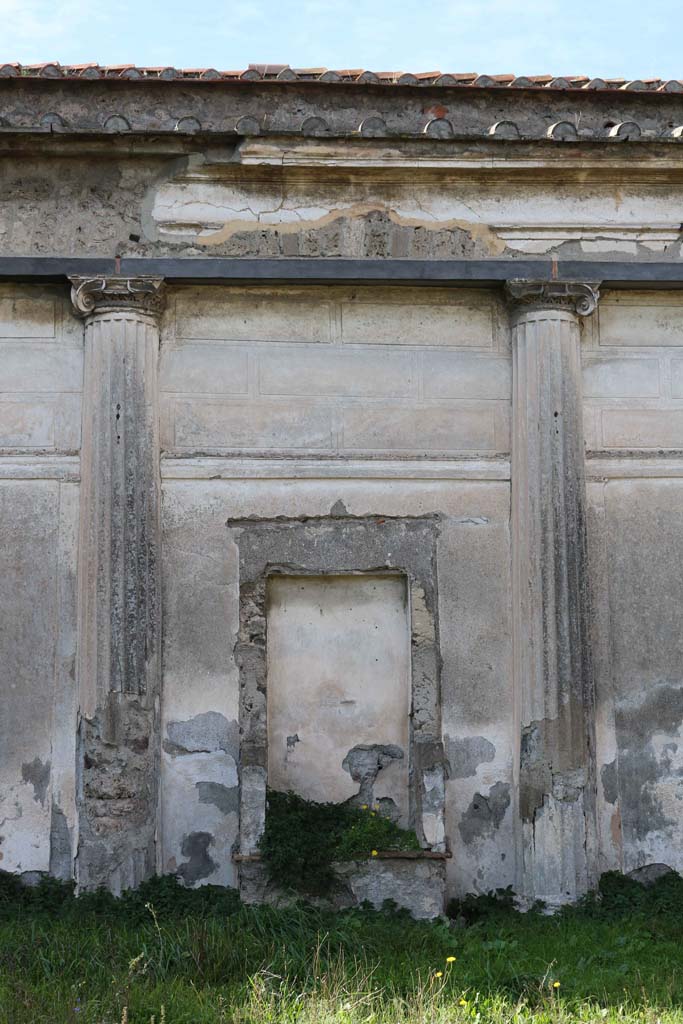
VII.4.52 Pompeii, on right. December 2018.
Looking towards west wall of shop, on right, with square niche. Photo courtesy of Aude Durand.
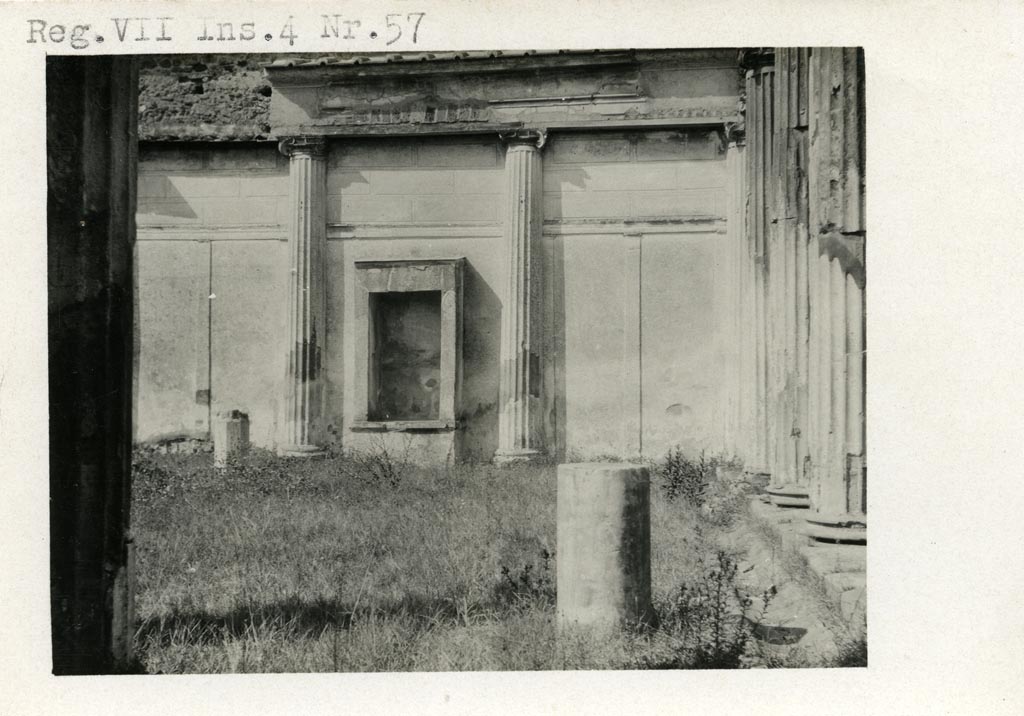
VII.4.52 Pompeii, December 2018. Looking towards square niche set into west wall of shop. Photo courtesy of Aude Durand.
According to Boyce –
In the west wall is
a rectangular niche (h.0.35, w.0.37, d.0.30, h. above floor 1,40) and in the
east wall is an arched niche (h.0.27, w.0.27, d.0.20, h. above floor 0.95); one
of them was probably a lararium.
See Boyce G. K.,
1937. Corpus of the Lararia of Pompeii.
Rome:
MAAR 14. (p.66, no.280).
VII.4.56 Pompeii.
Two niches on north wall of atrium, with Lararium painting (poorly preserved at time of excavation).
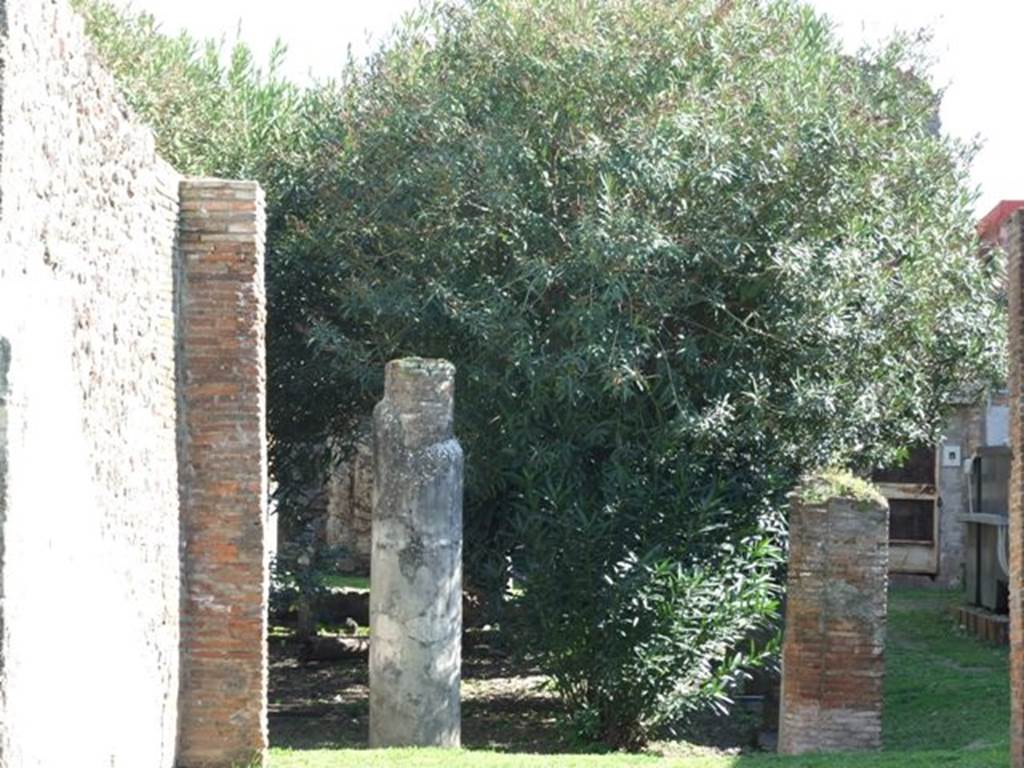
VII.4.56 Pompeii.
March 2009. Room 1, atrium. North wall and north-east corner, with recess.
Under the dead ivy
in the top left-hand corner are 2 lararium niches.
According to Boyce,
above a red dado (height 1.32) ran a cornice of painted stucco and above it was
the lararium painting.
It was on a white
background, but poorly preserved when excavated.
The painting showed
a human figure sacrificing at an altar.
Above the painting
ran a second stucco cornice with a projecting ledge above that.
Resting on the ledge
were the bases of three fluted columns which framed the two niches.
One of the niches
was rectangular with its interior walls painted rose colour.
The other niche had
a vaulted ceiling and had white walls.
A fragment of a
half-column found nearby led Avellino to think that the whole shrine was
enclosed by an aedicula.
He quotes his
sources as: Avellino, Mem. Accad. Ercolanese, iii, 1843, 365; and Breton,
374.
See Boyce G. K.,
1937. Corpus of the Lararia of Pompeii.
Rome:
MAAR 14. (p.66, no.281)
See Giacobello, F., 2008. Larari Pompeiani: Iconografia e culto dei Lari
in ambito domestico. Milano: LED Edizioni, (p.245, no.A27)
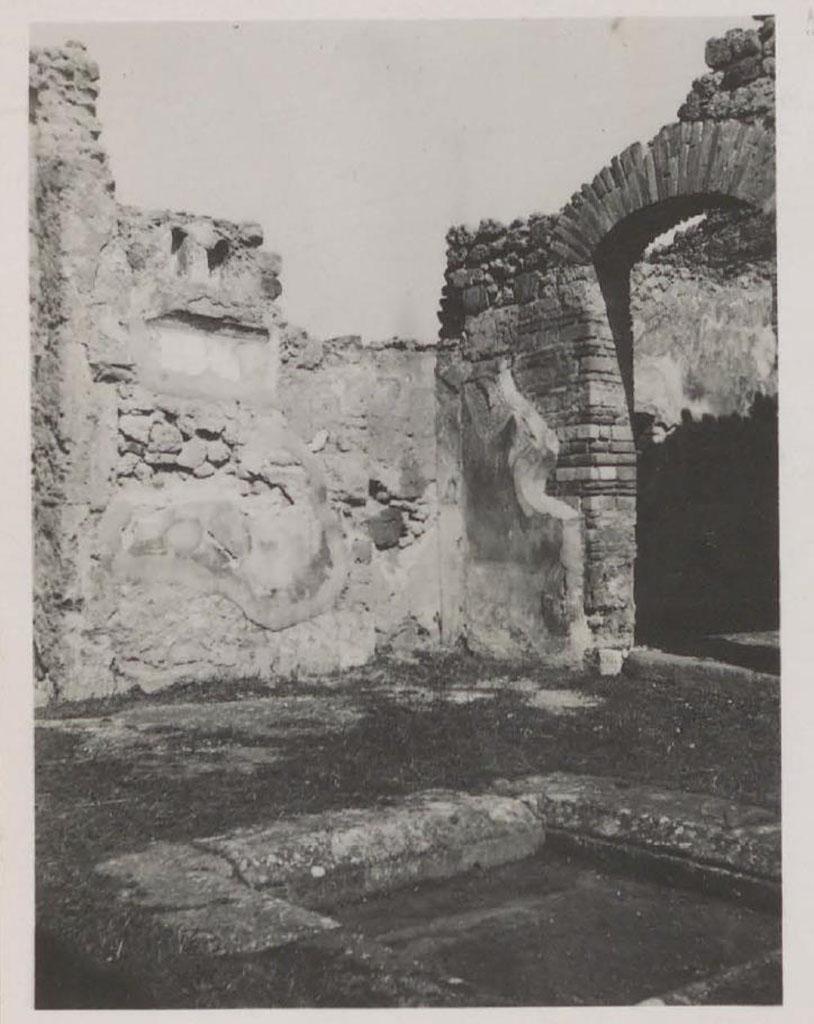
VII.4.56 Pompeii.
Pre 1942. Room 1, atrium. Looking towards north-east corner.
On the left at the
top of the north wall, two lararium niches can be seen.
See Warscher, T. 1942. Catalogo illustrato degli affreschi del Museo
Nazionale di Napoli. Sala
LXXIX. Vol.1. Rome, Swedish
Institute.
VII.4.57 Pompeii.
Aedicula lararium against west wall of peristyle.
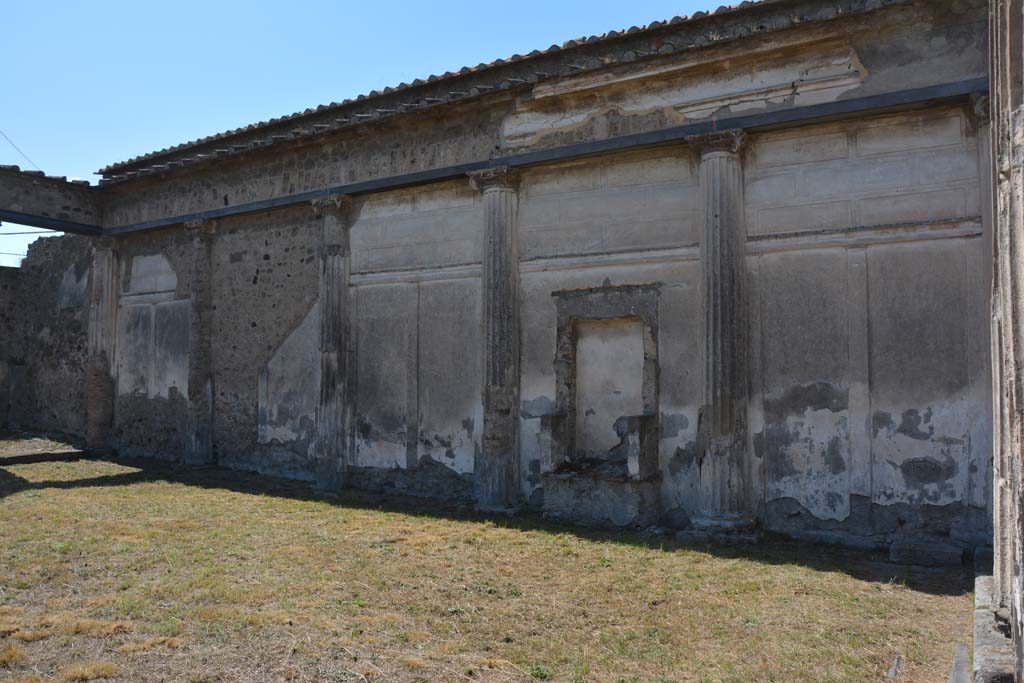
VII.4.57 Pompeii.
September 2019. Looking towards west wall of peristyle.
Foto Annette Haug, ERC Grant 681269 DÉCOR.
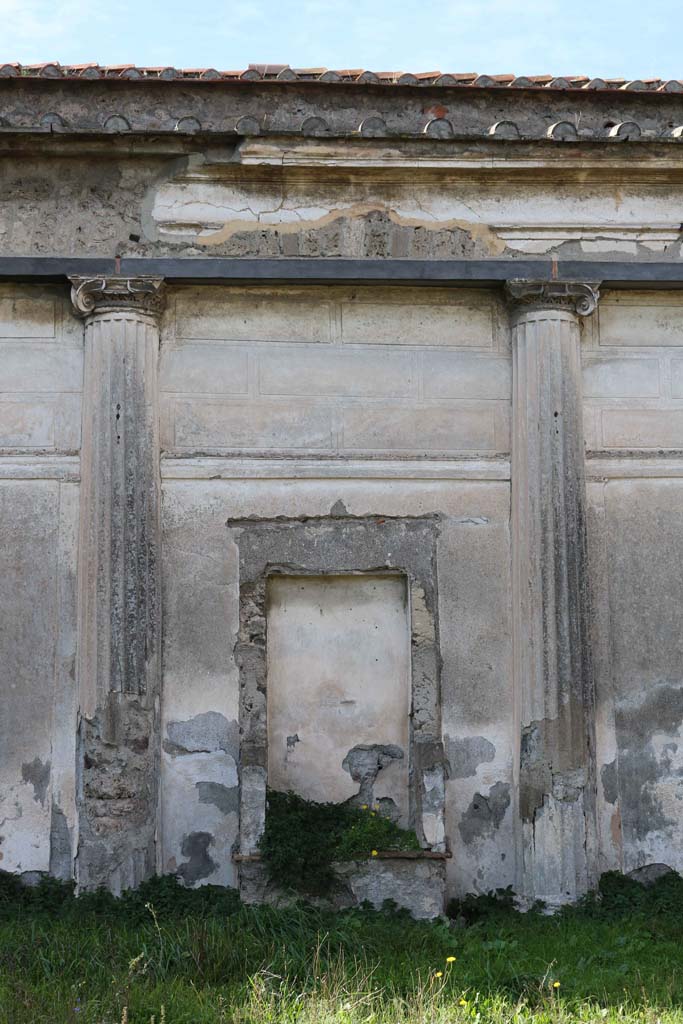
VII.4.57 Pompeii. December 2018.
Aedicula Lararium, set into west wall of peristyle. Photo courtesy of Aude Durand.
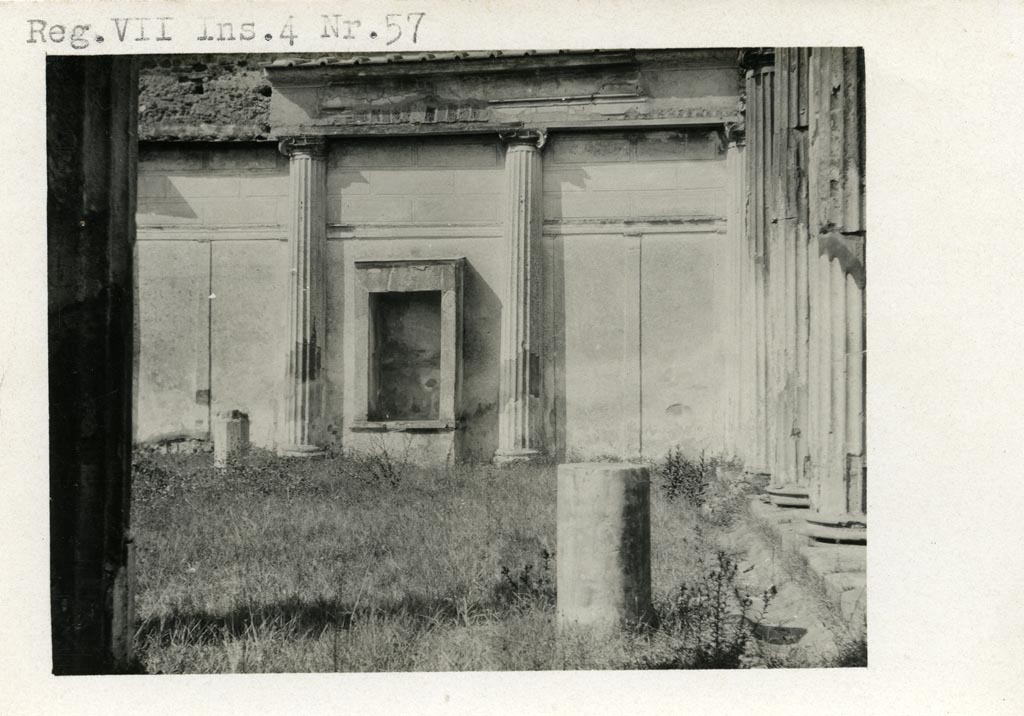
VII.4.57 Pompeii. Pre-1937-39. Aedicula Lararium against west wall of
peristyle.
Photo courtesy of American Academy in Rome,
Photographic Archive. Warsher collection no. 1773.
According to Boyce, the row of columns
forming the western portico of the peristyle is built into the wall.
A rectangular niche (h.1.75, w.0.90, d.0.60)
bordered by solid walls stands upon a masonry base (h.0.65).
See Boyce G. K., 1937. Corpus of the Lararia of Pompeii. Rome: MAAR 14. (p.66, no.282, and
Pl.35,3).
See Giacobello, F., 2008. Larari Pompeiani: Iconografia e culto dei Lari
in ambito domestico. Milano:
LED Edizioni, (p.281 no.V68).
VII.4.59 Pompeii.
Niche and lararium painting in kitchen near south-west corner of peristyle. (No photo).
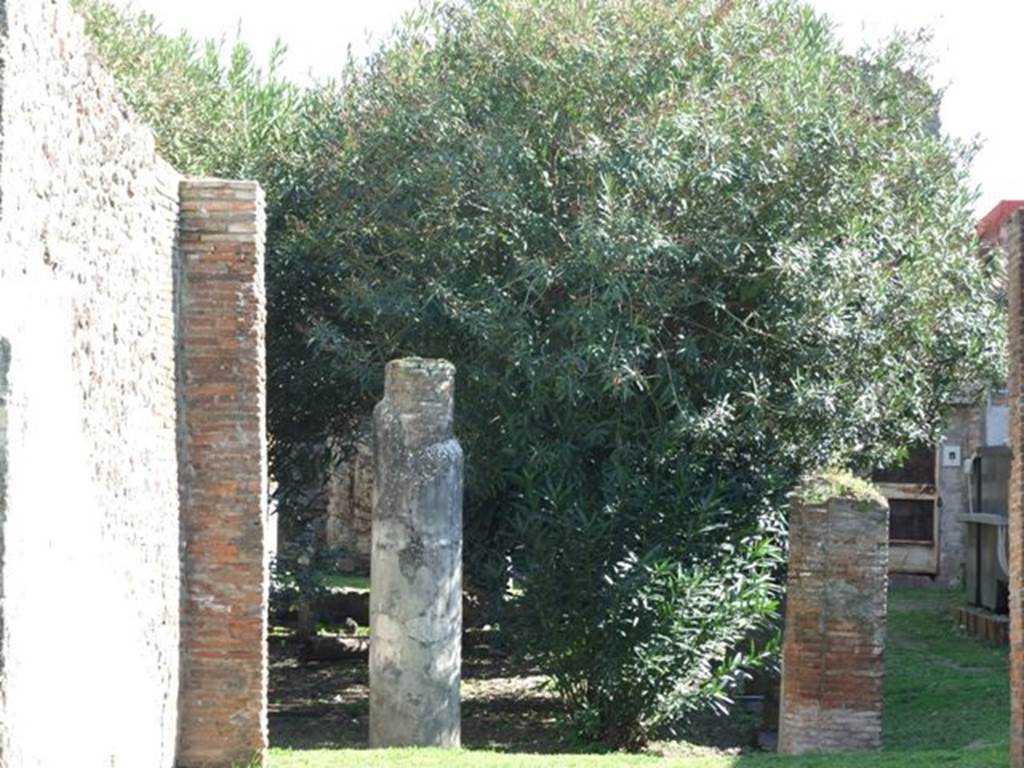
VII.4.59 Pompeii.
March 2009. Peristyle o, west side, looking south.
According to Boyce,
in the south-west corner of the peristyle was the doorway to the kitchen.
In this kitchen was
a niche and Lararium. The niche had its interior walls painted with spots of
many colours.
Painted on the wall
to the right of the niche was a Lar wearing a yellow tunic and green pallium,
carrying rhyton and situla.
Behind the Lar and
somewhat bigger, was Vulcan holding tongs in his right hand and his left
resting on a shield.
The figures on the
left side of the niche had vanished.
In the lower zone
was a serpent beside and altar.
Boyce made a note
that Avellino thought that Vulcan’s appearance in the Lararium painting was a
reference to the business of the owner.
The shops at numbers
60 and 61 to the right of this house, were apparently owned by a bronze worker.
See Boyce G. K.,
1937. Corpus of the Lararia of Pompeii.
Rome:
MAAR 14. (p.66, no.283)
See Avellino F., 1843. Descrizione di una casa dissotterrata in Pompei negli anni 1832, 1833 e
1834., Napoli, Memorie della R. Acc. Ercolanese III, 1843.
According to PPM –
Following on from
the damage caused by the bombardment during the Second World War, the rooms
(p), (q), ( r), (s), (t), (u) and (v), previously situated to the west and
south-west of the peristyle, are now lost and have been incorporated into the
buildings of the Direzione degli Scavi. However, we have the description by Avellino, who
had the opportunity to see them.
See Carratelli, G. P., 1990-2003. Pompei:
Pitture e Mosaici. VII (7). Roma: Istituto della enciclopedia italiana, (p.93).
Back to household shrines list